
The University of the State of New York
REGENTS HIGH SCHOOL EXAMINATION
ALGEBRA II
Wednesday, August 14, 2019 — 12:30 to 3:30 p.m., only
MODEL RESPONSE SET
Table of Contents
Question 25. . . . . . . . . . . . . . . . . . 2
Question 26. . . . . . . . . . . . . . . . . . 7
Question 27. . . . . . . . . . . . . . . . . 11
Question 28. . . . . . . . . . . . . . . . . 16
Question 29. . . . . . . . . . . . . . . . . 19
Question 30. . . . . . . . . . . . . . . . . 23
Question 31. . . . . . . . . . . . . . . . . 28
Question 32. . . . . . . . . . . . . . . . . 32
Question 33. . . . . . . . . . . . . . . . . 37
Question 34. . . . . . . . . . . . . . . . . 44
Question 35. . . . . . . . . . . . . . . . . 49
Question 36. . . . . . . . . . . . . . . . . 55
Question 37. . . . . . . . . . . . . . . . . 63
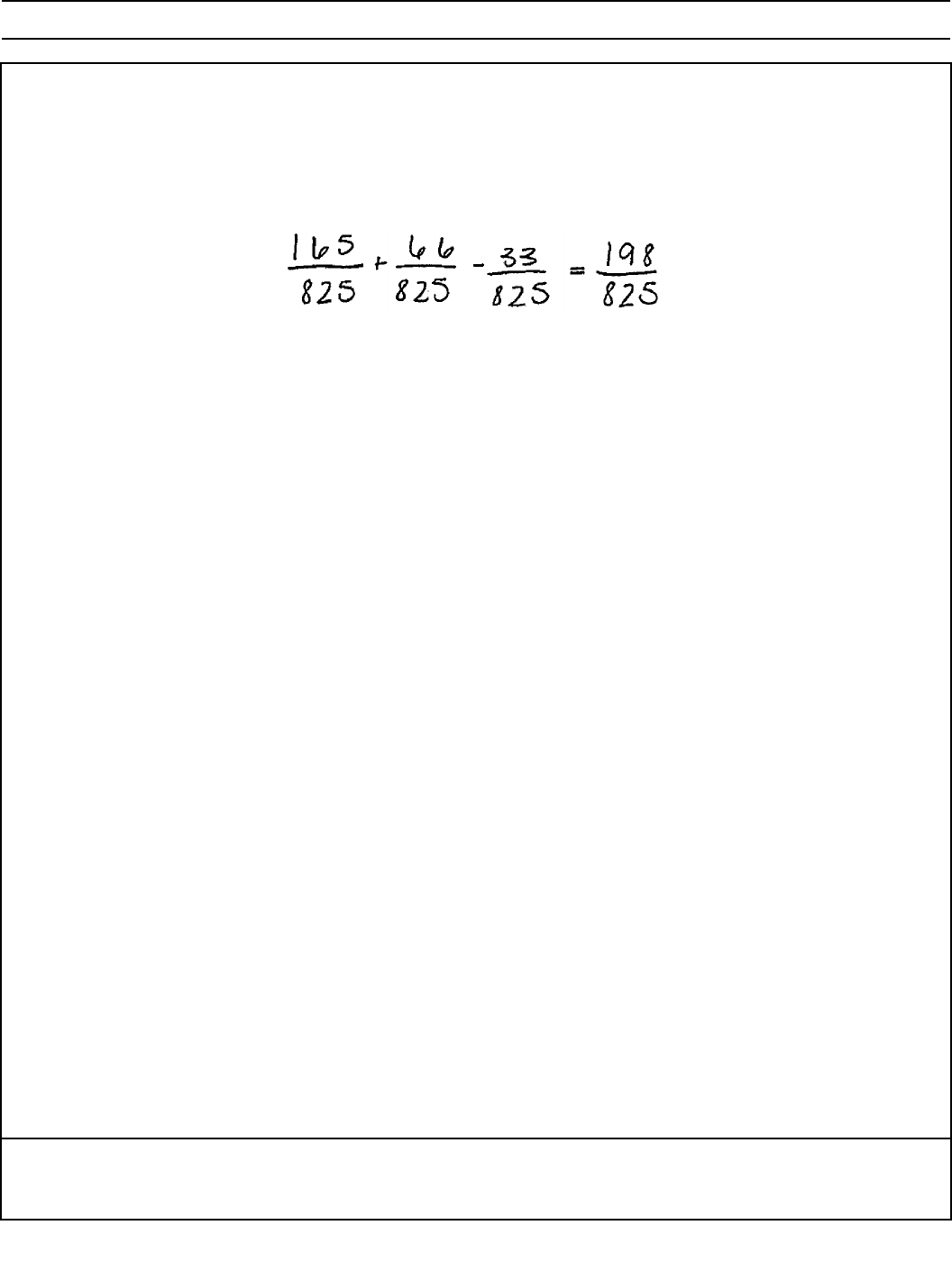
Algebra II – Aug. ’19 [2]
Question 25
Score 2: The student gave a complete and correct response.
25 At Andrew Jackson High School, students are only allowed to enroll in AP U.S. History if they
have already taken AP World History or AP European History. Out of 825 incoming seniors, 165
took AP World History, 66 took AP European History, and 33 took both. Given this information,
determine the probability a randomly selected incoming senior is allowed to enroll in AP U.S.
History.
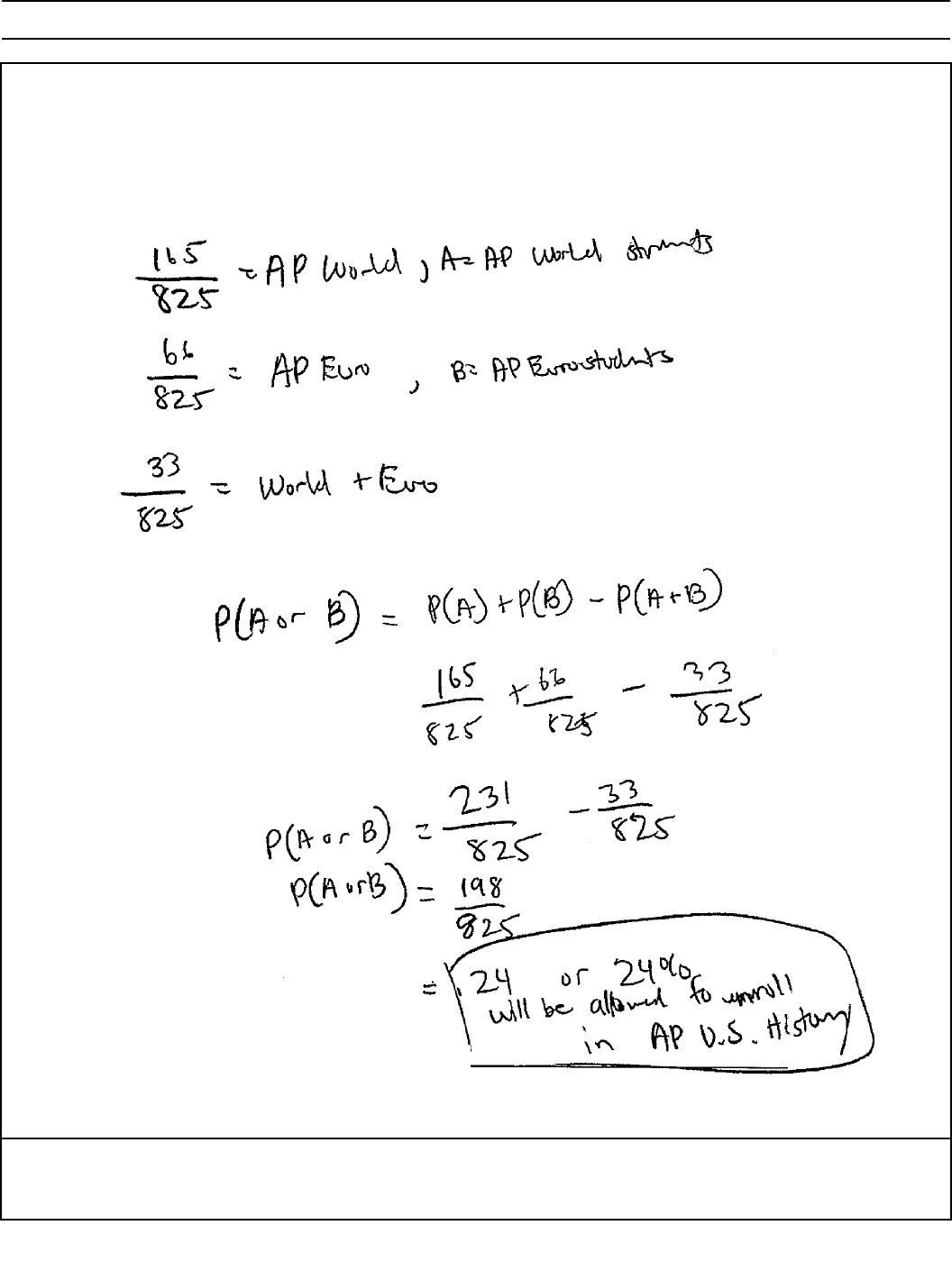
Algebra II – Aug. ’19 [3]
Question 25
Score 2: The student gave a complete and correct response.
25 At Andrew Jackson High School, students are only allowed to enroll in AP U.S. History if they
have already taken AP World History or AP European History. Out of 825 incoming seniors, 165
took AP World History, 66 took AP European History, and 33 took both. Given this information,
determine the probability a randomly selected incoming senior is allowed to enroll in AP U.S.
History.
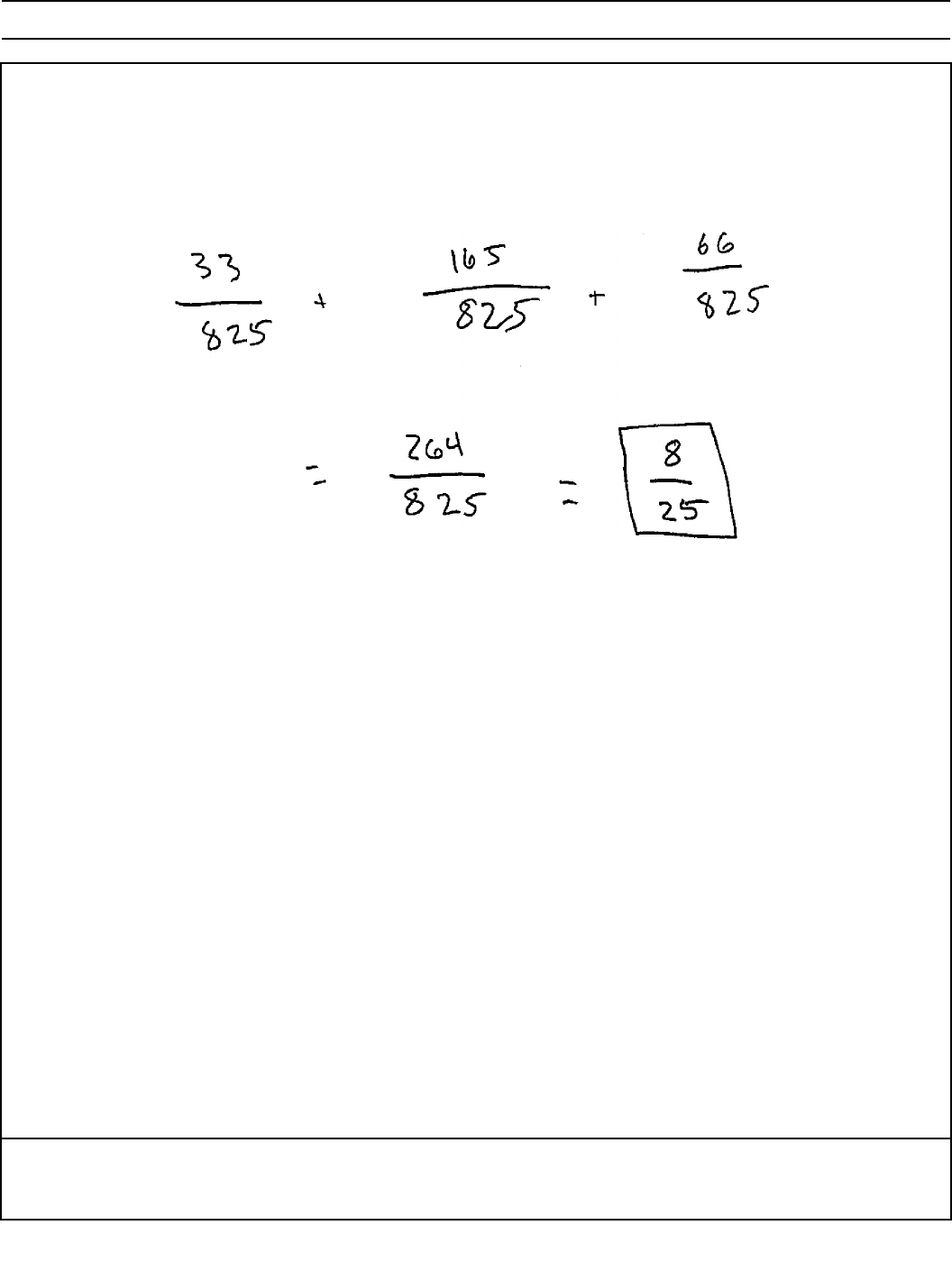
Algebra II – Aug. ’19 [4]
Question 25
Score 1: The student misapplied the addition rule.
25 At Andrew Jackson High School, students are only allowed to enroll in AP U.S. History if they
have already taken AP World History or AP European History. Out of 825 incoming seniors, 165
took AP World History, 66 took AP European History, and 33 took both. Given this information,
determine the probability a randomly selected incoming senior is allowed to enroll in AP U.S.
History.
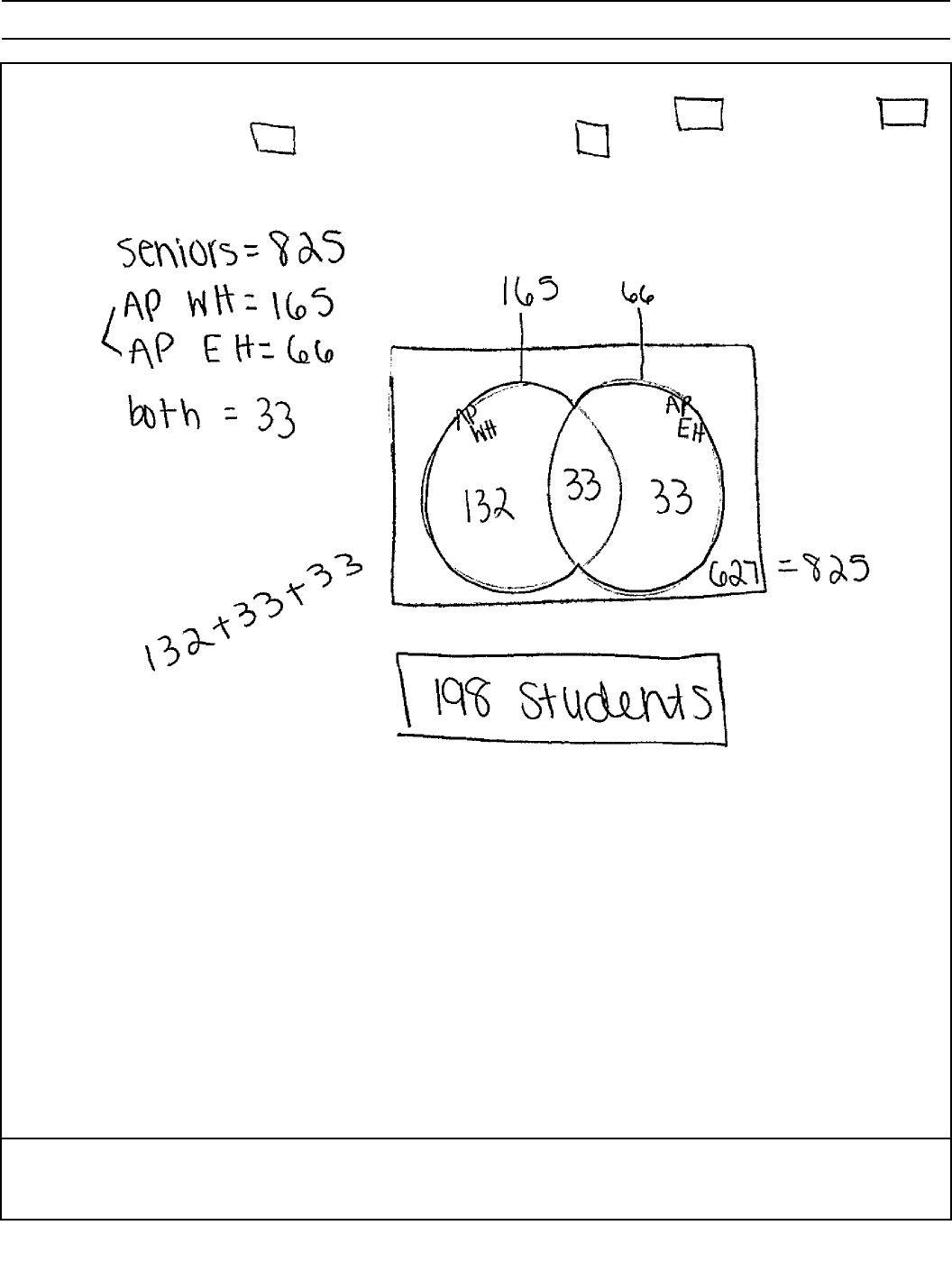
25 At Andrew Jackson High School, students are only allowed to enroll in AP U.S. History if they
have already taken AP World History or AP European History. Out of 825 incoming seniors, 165
took AP World History, 66 took AP European History, and 33 took both. Given this information,
determine the probability a randomly selected incoming senior is allowed to enroll in AP U.S.
History.
Algebra II – Aug. ’19 [5]
Question 25
Score 1: The student did not divide by 825.

Algebra II – Aug. ’19 [6]
Question 25
Score 0: The student did not show enough correct work to receive any credit.
25 At Andrew Jackson High School, students are only allowed to enroll in AP U.S. History if they
have already taken AP World History or AP European History. Out of 825 incoming seniors, 165
took AP World History, 66 took AP European History, and 33 took both. Given this information,
determine the probability a randomly selected incoming senior is allowed to enroll in AP U.S.
History.
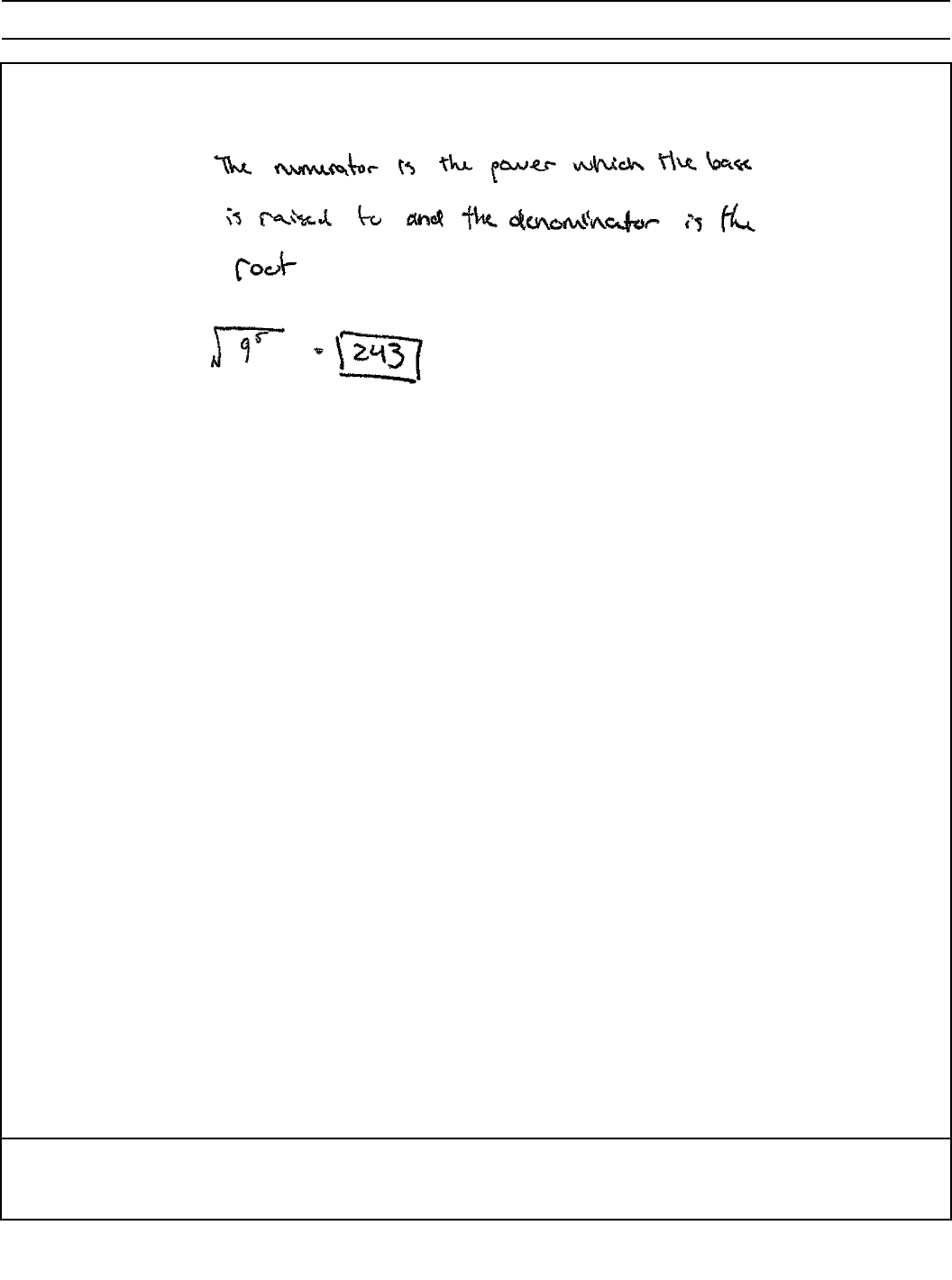
Algebra II – Aug. ’19 [7]
Question 26
Score 2: The student gave a complete and correct response.
26 Explain what a rational exponent, such as
5
__
2
means. Use this explanation to evaluate 9 .
5
__
2

Algebra II – Aug. ’19 [8]
Question 26
Score 2: The student gave a complete and correct response.
26 Explain what a rational exponent, such as
5
__
2
means. Use this explanation to evaluate 9 .
5
__
2
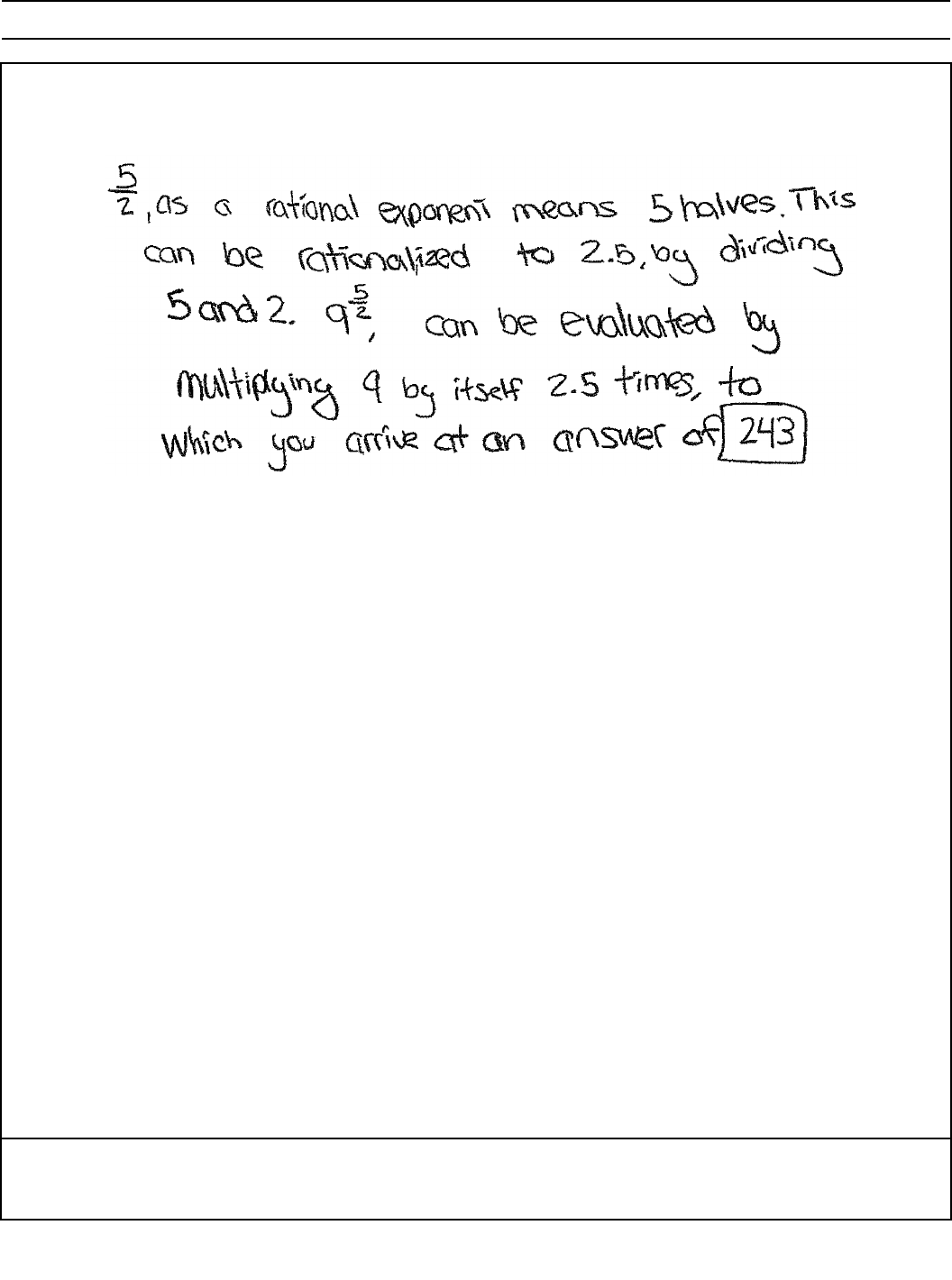
Algebra II – Aug. ’19 [9]
Question 26
Score 1: The student gave an incomplete explanation.
26 Explain what a rational exponent, such as
5
__
2
means. Use this explanation to evaluate 9 .
5
__
2
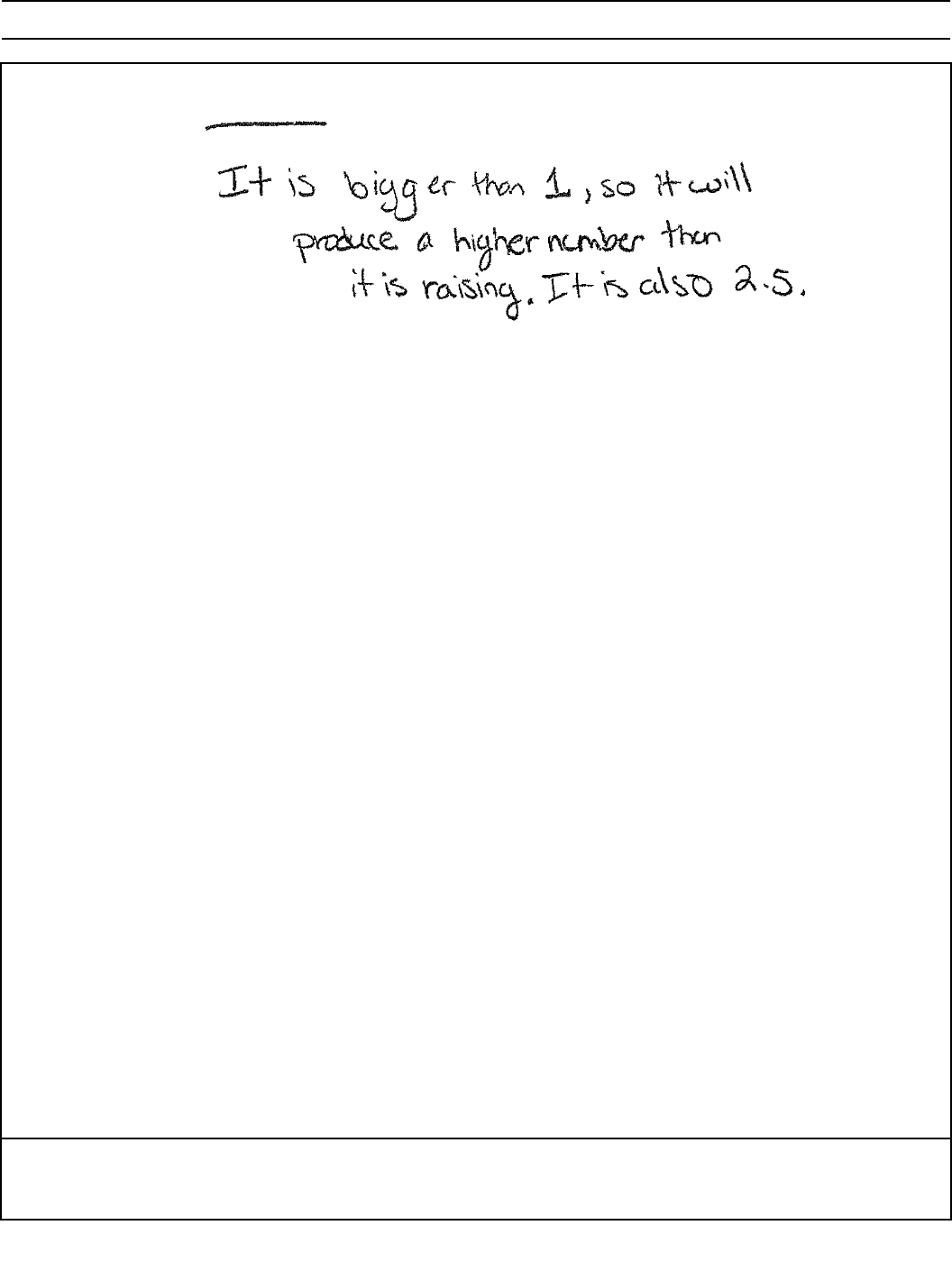
Algebra II – Aug. ’19 [10]
Question 26
Score 0: The student did not provide a correct explanation.
26 Explain what a rational exponent, such as
5
__
2
means. Use this explanation to evaluate 9 .
5
__
2

Algebra II – Aug. ’19 [11]
Question 27
Score 2: The student gave a complete and correct response.
27 Write ⫺
1
__
2
i
3
(
兹苵苵苵
⫺9 ⫺ 4
)
⫺ 3i
2
in simplest a ⫹ bi form.

Algebra II – Aug. ’19 [12]
Question 27
Score 2: The student gave a complete and correct response.
27 Write ⫺
1
__
2
i
3
(
兹苵苵苵
⫺9 ⫺ 4
)
⫺ 3i
2
in simplest a ⫹ bi form.
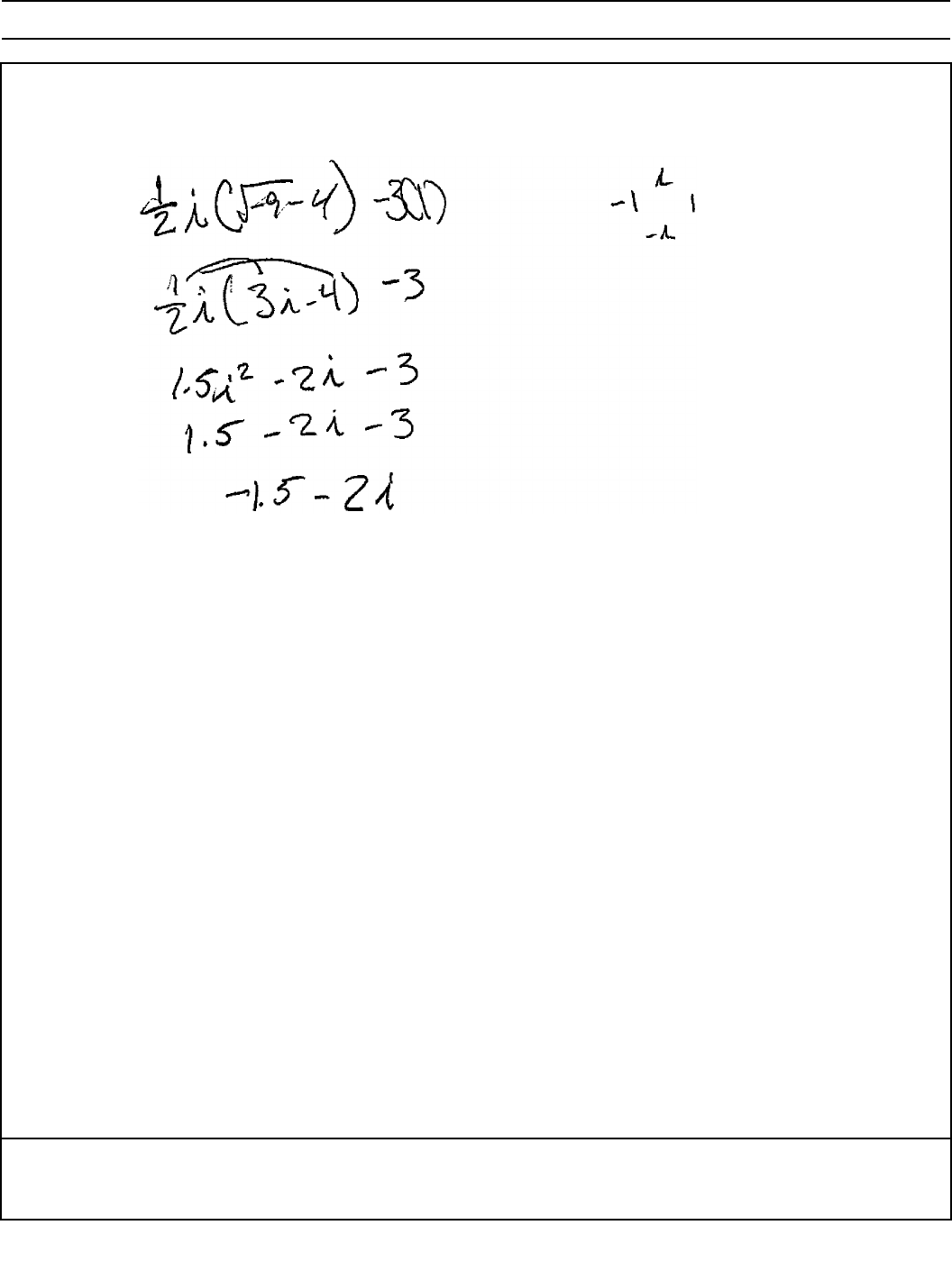
Algebra II – Aug. ’19 [13]
Question 27
Score 1: The student incorrectly substituted for i
2
.
27 Write ⫺
1
__
2
i
3
(
兹苵苵苵
⫺9 ⫺ 4
)
⫺ 3i
2
in simplest a ⫹ bi form.
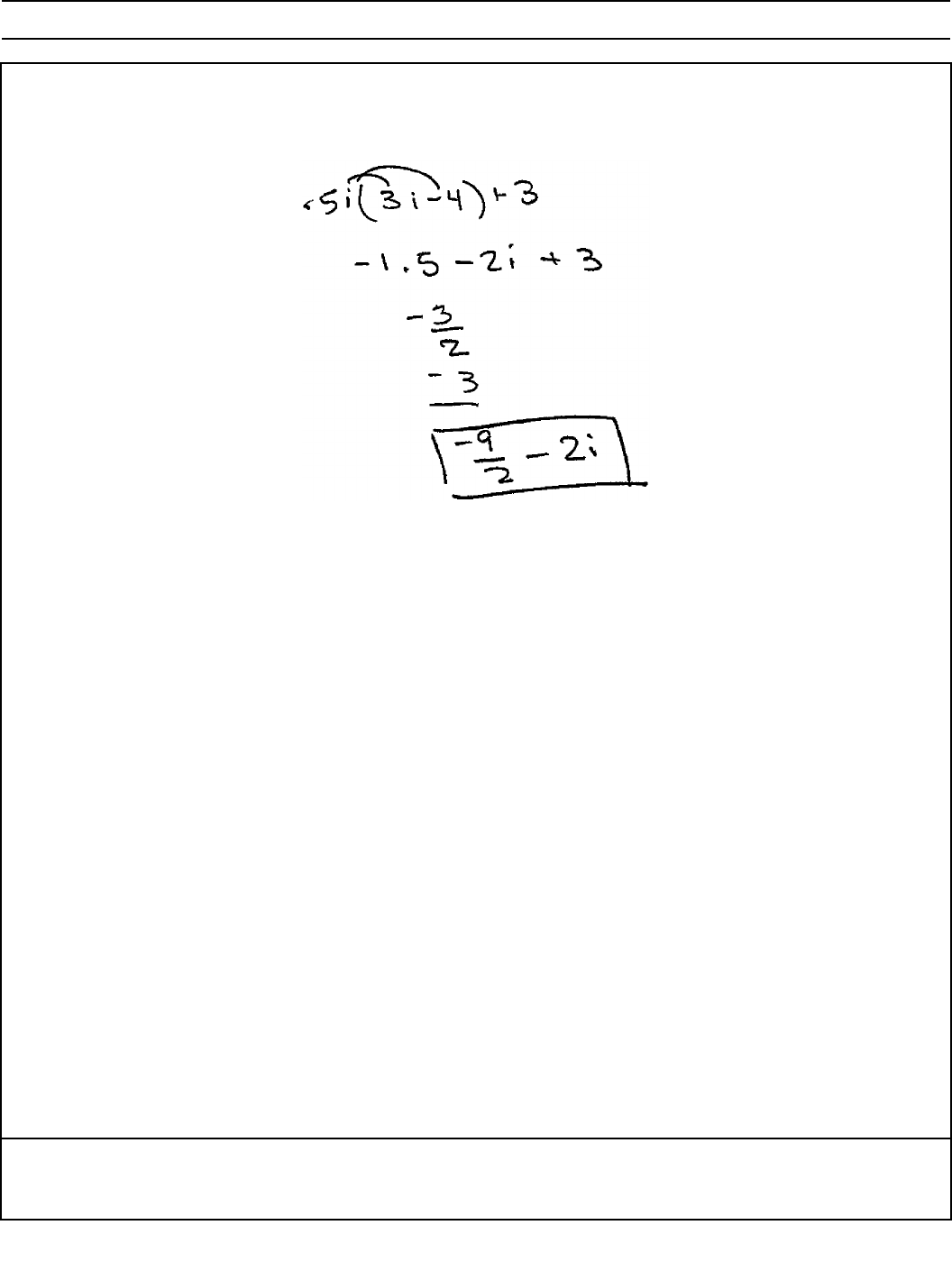
Algebra II – Aug. ’19 [14]
Question 27
Score 1: The student made one computational error.
27 Write ⫺
1
__
2
i
3
(
兹苵苵苵
⫺9 ⫺ 4
)
⫺ 3i
2
in simplest a ⫹ bi form.

Algebra II – Aug. ’19 [15]
Question 27
Score 0: The student made multiple computational errors.
27 Write ⫺
1
__
2
i
3
(
兹苵苵苵
⫺9 ⫺ 4
)
⫺ 3i
2
in simplest a ⫹ bi form.
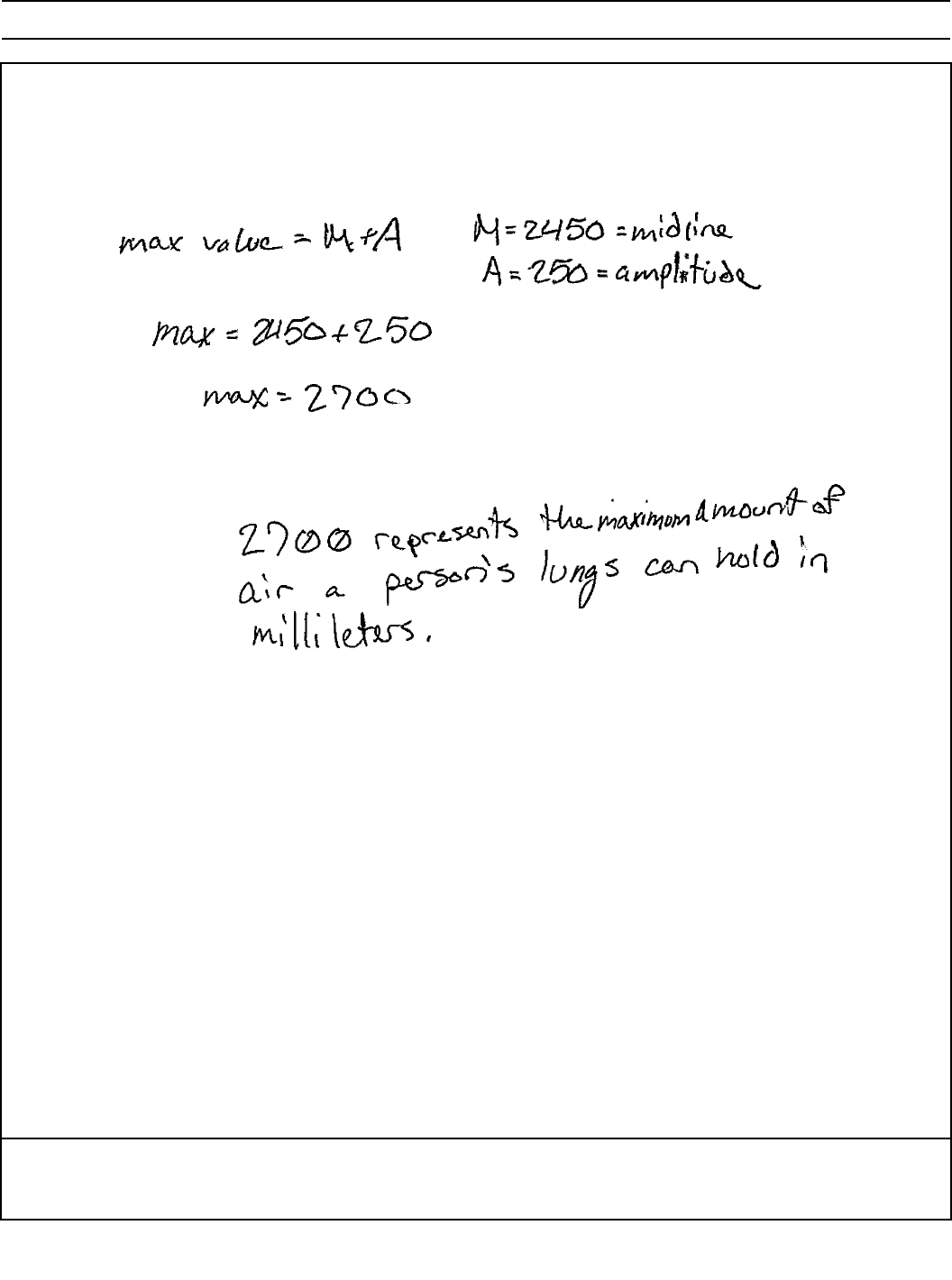
Algebra II – Aug. ’19 [16]
Question 28
Score 2: The student gave a complete and correct response.
28 A person’s lung capacity can be modeled by the function C(t) ⫽ 250sin
(
2π
___
5
t
)
⫹ 2450, where C(t)
represents the volume in mL present in the lungs after t seconds. State the maximum value of
this function over one full cycle, and explain what this value represents.

Algebra II – Aug. ’19 [17]
Question 28
Score 1: The student gave an incorrect explanation.
28 A person’s lung capacity can be modeled by the function C(t) ⫽ 250sin
(
2π
___
5
t
)
⫹ 2450, where C(t)
represents the volume in mL present in the lungs after t seconds. State the maximum value of
this function over one full cycle, and explain what this value represents.

Algebra II – Aug. ’19 [18]
Question 28
Score 0: The student did not show enough correct work to receive any credit.
28 A person’s lung capacity can be modeled by the function C(t) ⫽ 250sin
(
2π
___
5
t
)
⫹ 2450, where C(t)
represents the volume in mL present in the lungs after t seconds. State the maximum value of
this function over one full cycle, and explain what this value represents.

Algebra II – Aug. ’19 [19]
Question 29
Score 2: The student gave a complete and correct response.
29 Determine for which polynomial(s) (x ⫹ 2) is a factor. Explain your answer.
P(x) ⫽ x
4
⫺ 3x
3
⫺ 16x ⫺ 12
Q(x) ⫽ x
3
⫺ 3x
2
⫺ 16x ⫺ 12
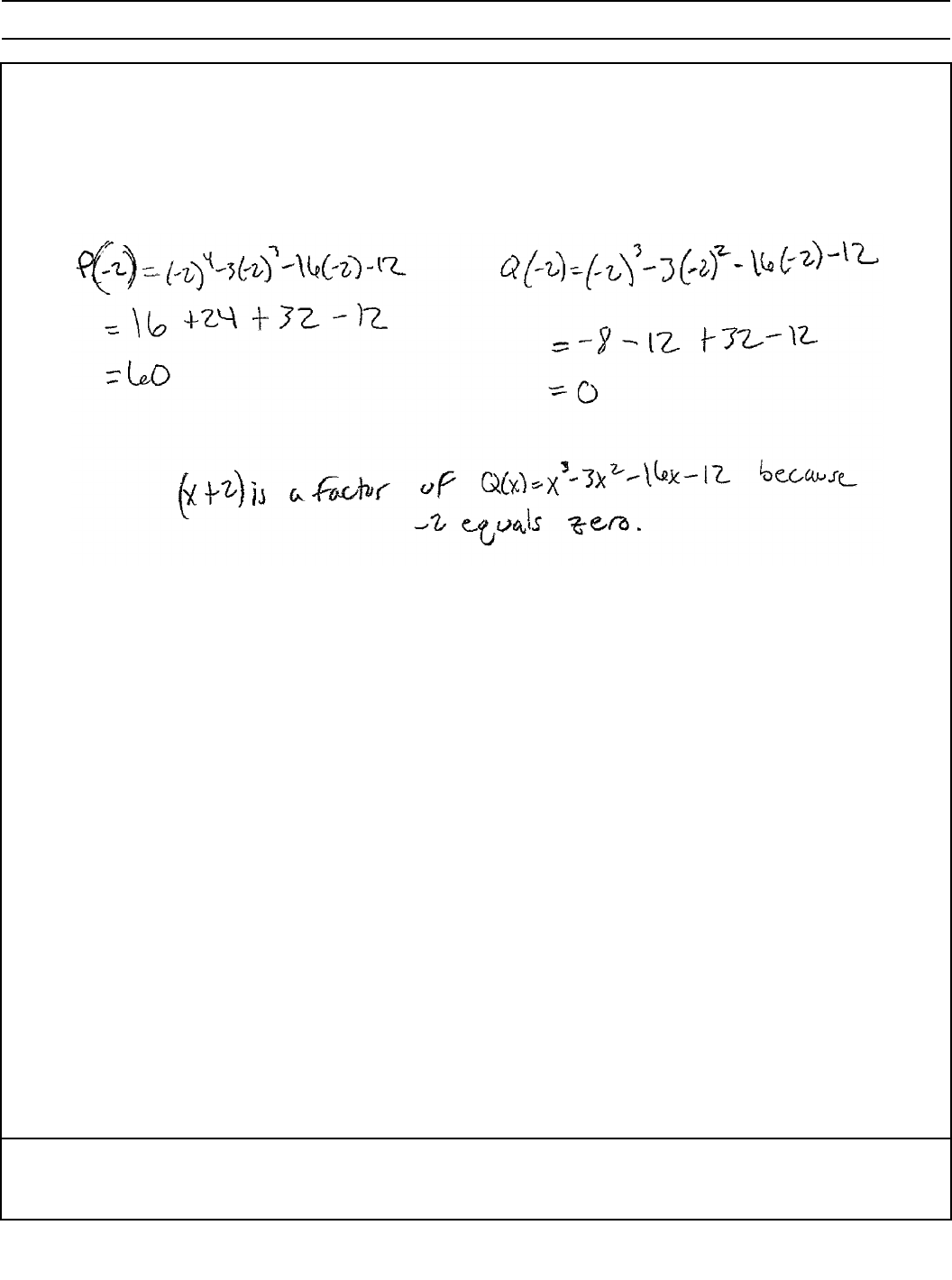
Algebra II – Aug. ’19 [20]
Question 29
Score 1: The student gave an incomplete explanation.
29 Determine for which polynomial(s) (x ⫹ 2) is a factor. Explain your answer.
P(x) ⫽ x
4
⫺ 3x
3
⫺ 16x ⫺ 12
Q(x) ⫽ x
3
⫺ 3x
2
⫺ 16x ⫺ 12
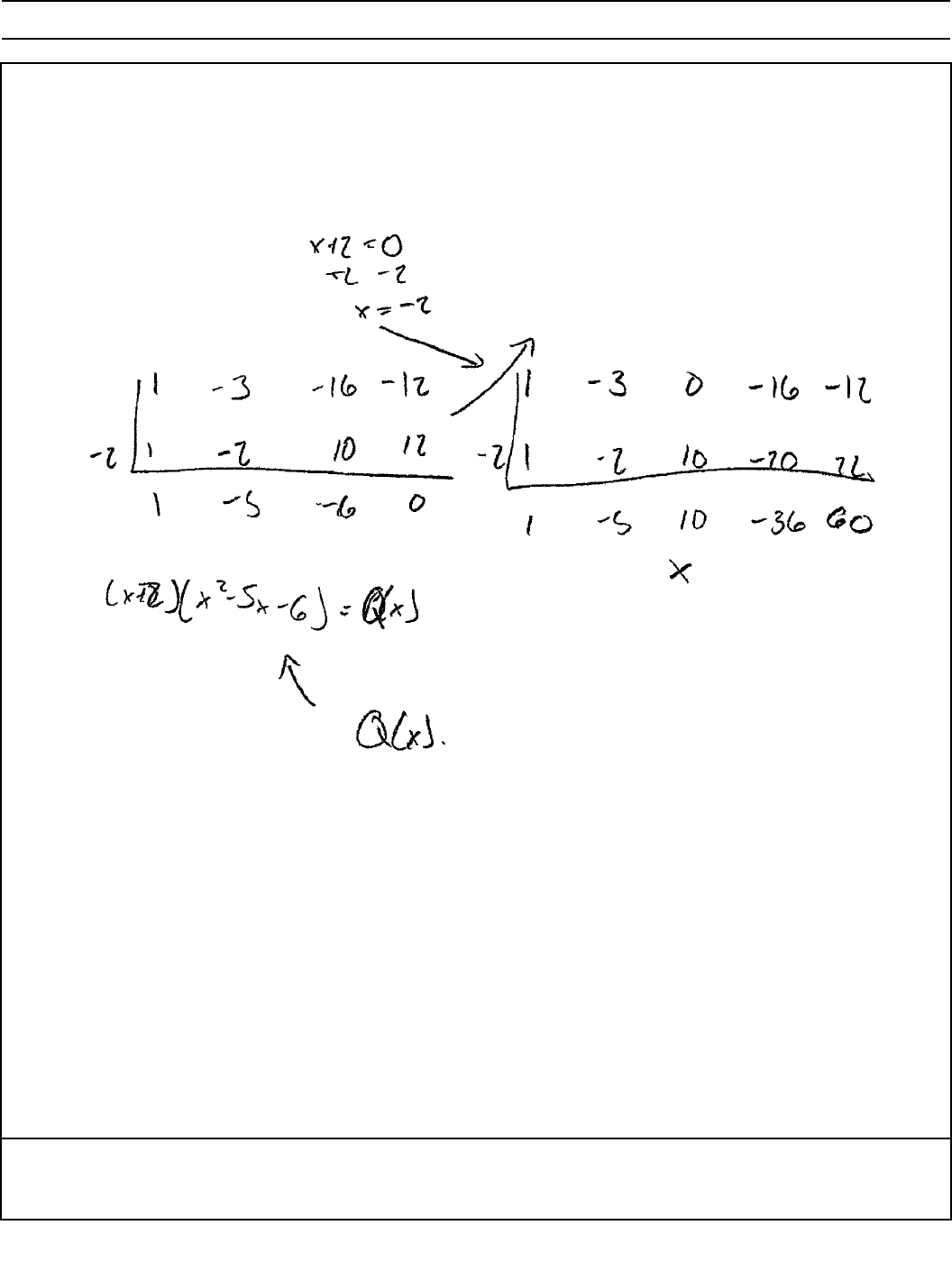
Algebra II – Aug. ’19 [21]
Question 29
Score 1: The student gave no explanation.
29 Determine for which polynomial(s) (x ⫹ 2) is a factor. Explain your answer.
P(x) ⫽ x
4
⫺ 3x
3
⫺ 16x ⫺ 12
Q(x) ⫽ x
3
⫺ 3x
2
⫺ 16x ⫺ 12

Algebra II – Aug. ’19 [22]
Question 29
Score 0: The student made multiple errors.
29 Determine for which polynomial(s) (x ⫹ 2) is a factor. Explain your answer.
P(x) ⫽ x
4
⫺ 3x
3
⫺ 16x ⫺ 12
Q(x) ⫽ x
3
⫺ 3x
2
⫺ 16x ⫺ 12
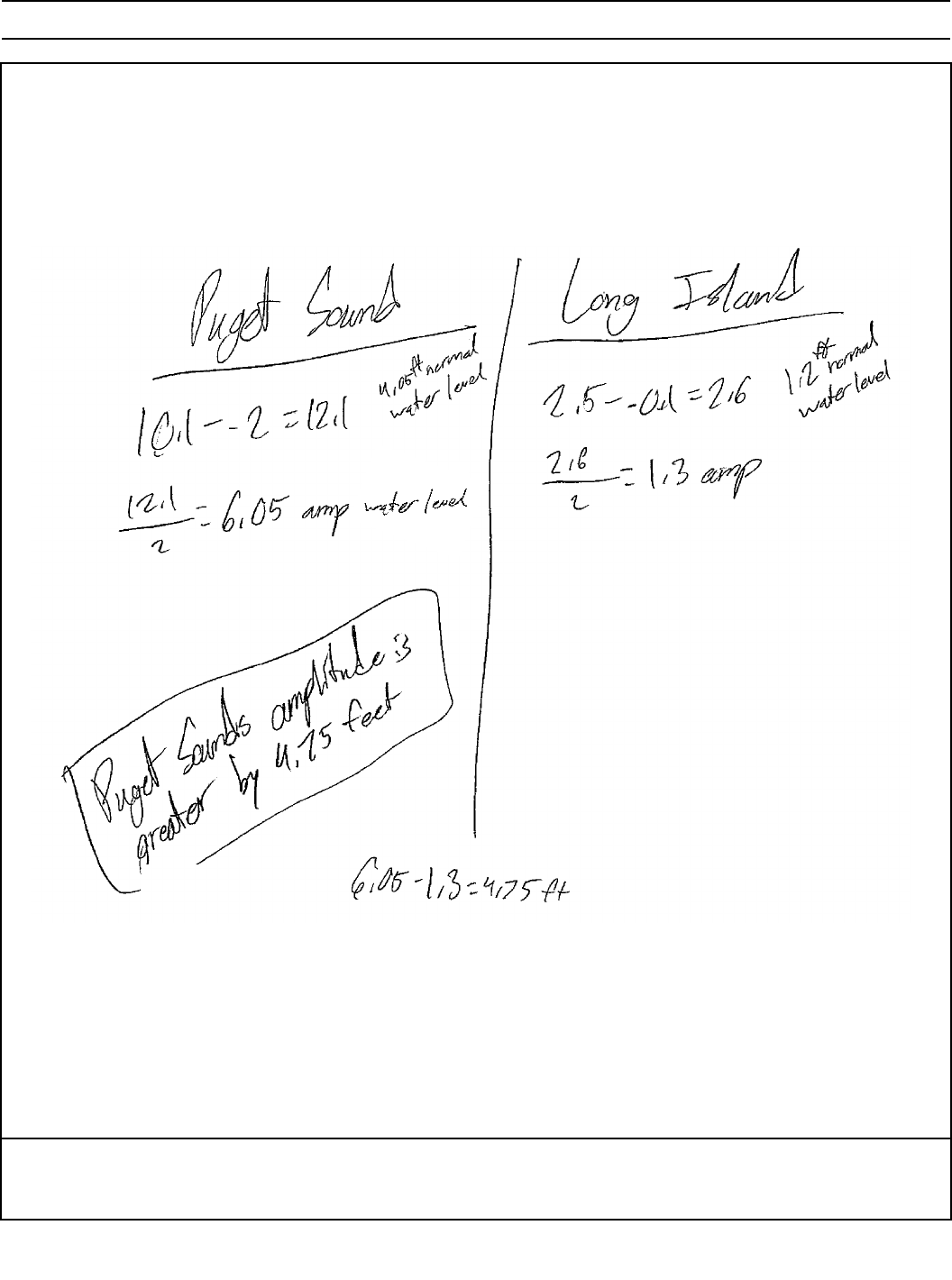
Algebra II – Aug. ’19 [23]
Question 30
Score 2: The student gave a complete and correct response.
30 On July 21, 2016, the water level in Puget Sound, WA reached a high of 10.1 ft at 6 a.m. and
a low of ⫺2 ft at 12:30 p.m. Across the country in Long Island, NY, Shinnecock Bay’s water level
reached a high of 2.5 ft at 10:42 p.m. and a low of ⫺0.1 ft at 5:31 a.m.
The water levels of both locations are affected by the tides and can be modeled by sinusoidal
functions. Determine the difference in amplitudes, in feet, for these two locations.
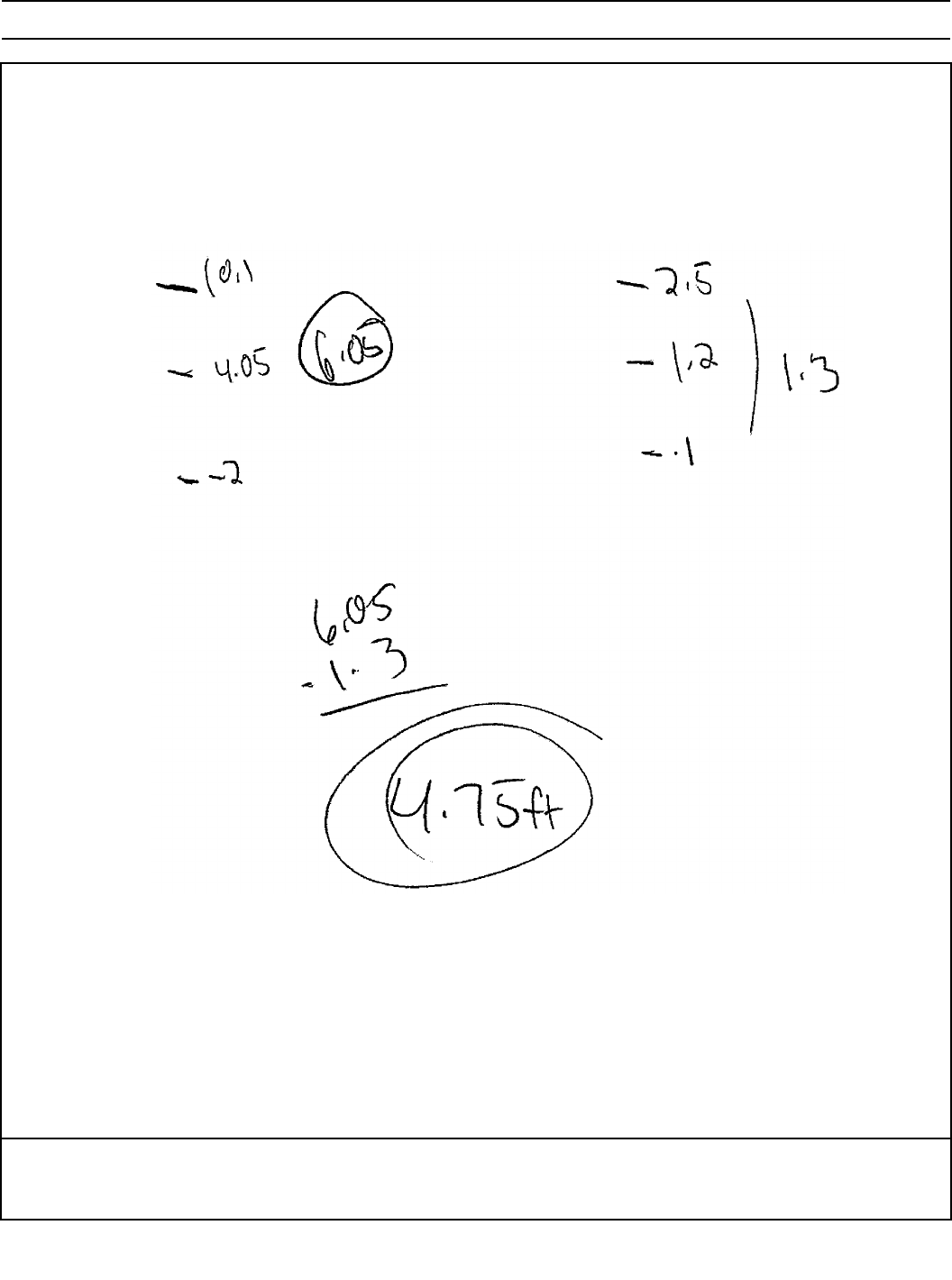
Algebra II – Aug. ’19 [24]
Question 30
Score 2: The student gave a complete and correct response.
30 On July 21, 2016, the water level in Puget Sound, WA reached a high of 10.1 ft at 6 a.m. and
a low of ⫺2 ft at 12:30 p.m. Across the country in Long Island, NY, Shinnecock Bay’s water level
reached a high of 2.5 ft at 10:42 p.m. and a low of ⫺0.1 ft at 5:31 a.m.
The water levels of both locations are affected by the tides and can be modeled by sinusoidal
functions. Determine the difference in amplitudes, in feet, for these two locations.
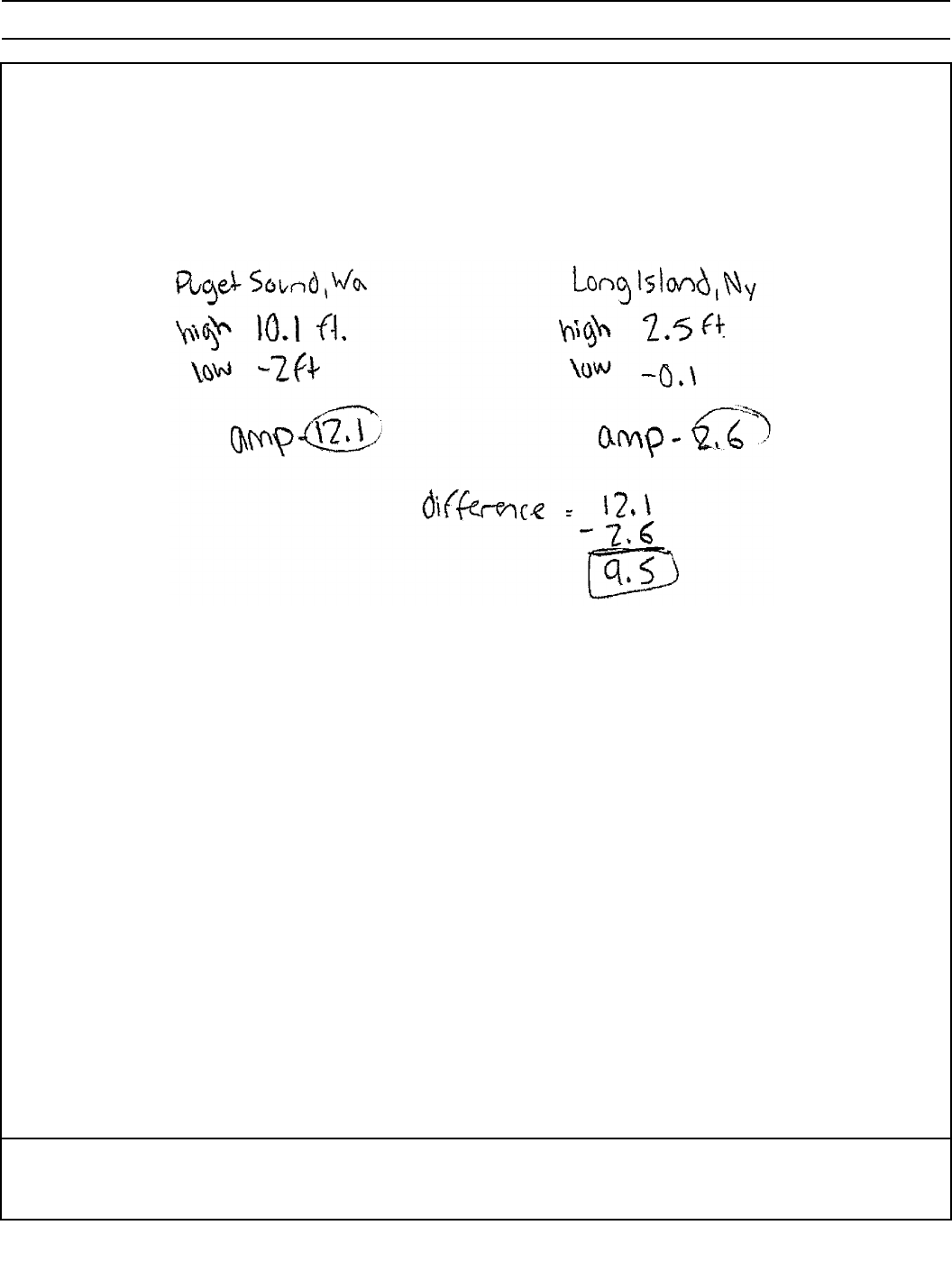
Algebra II – Aug. ’19 [25]
Question 30
Score 1: The student made an error finding the amplitudes.
30 On July 21, 2016, the water level in Puget Sound, WA reached a high of 10.1 ft at 6 a.m. and
a low of ⫺2 ft at 12:30 p.m. Across the country in Long Island, NY, Shinnecock Bay’s water level
reached a high of 2.5 ft at 10:42 p.m. and a low of ⫺0.1 ft at 5:31 a.m.
The water levels of both locations are affected by the tides and can be modeled by sinusoidal
functions. Determine the difference in amplitudes, in feet, for these two locations.
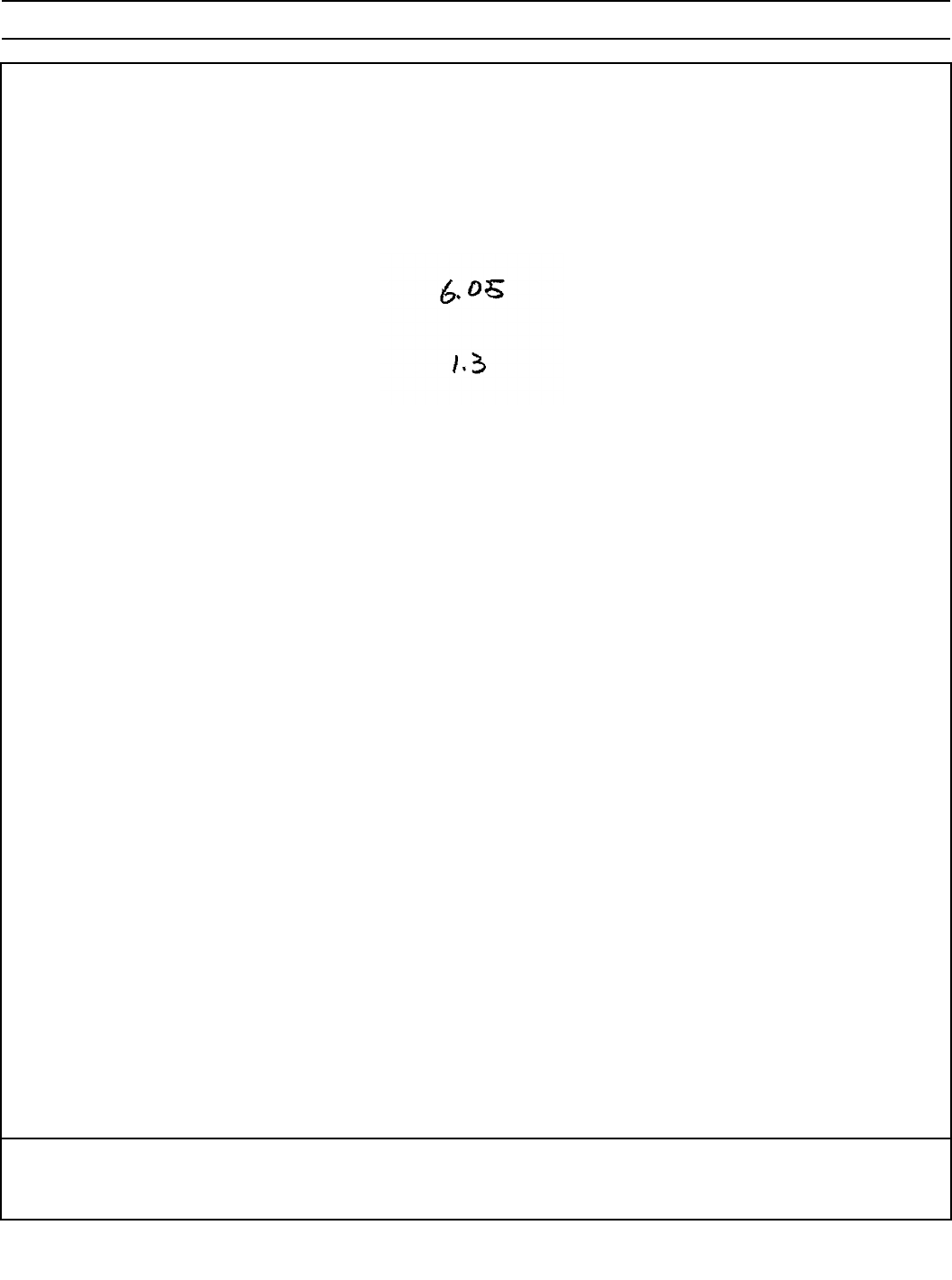
Algebra II – Aug. ’19 [26]
Question 30
Score 1: The student did not determine the difference in amplitudes.
30 On July 21, 2016, the water level in Puget Sound, WA reached a high of 10.1 ft at 6 a.m. and
a low of ⫺2 ft at 12:30 p.m. Across the country in Long Island, NY, Shinnecock Bay’s water level
reached a high of 2.5 ft at 10:42 p.m. and a low of ⫺0.1 ft at 5:31 a.m.
The water levels of both locations are affected by the tides and can be modeled by sinusoidal
functions. Determine the difference in amplitudes, in feet, for these two locations.
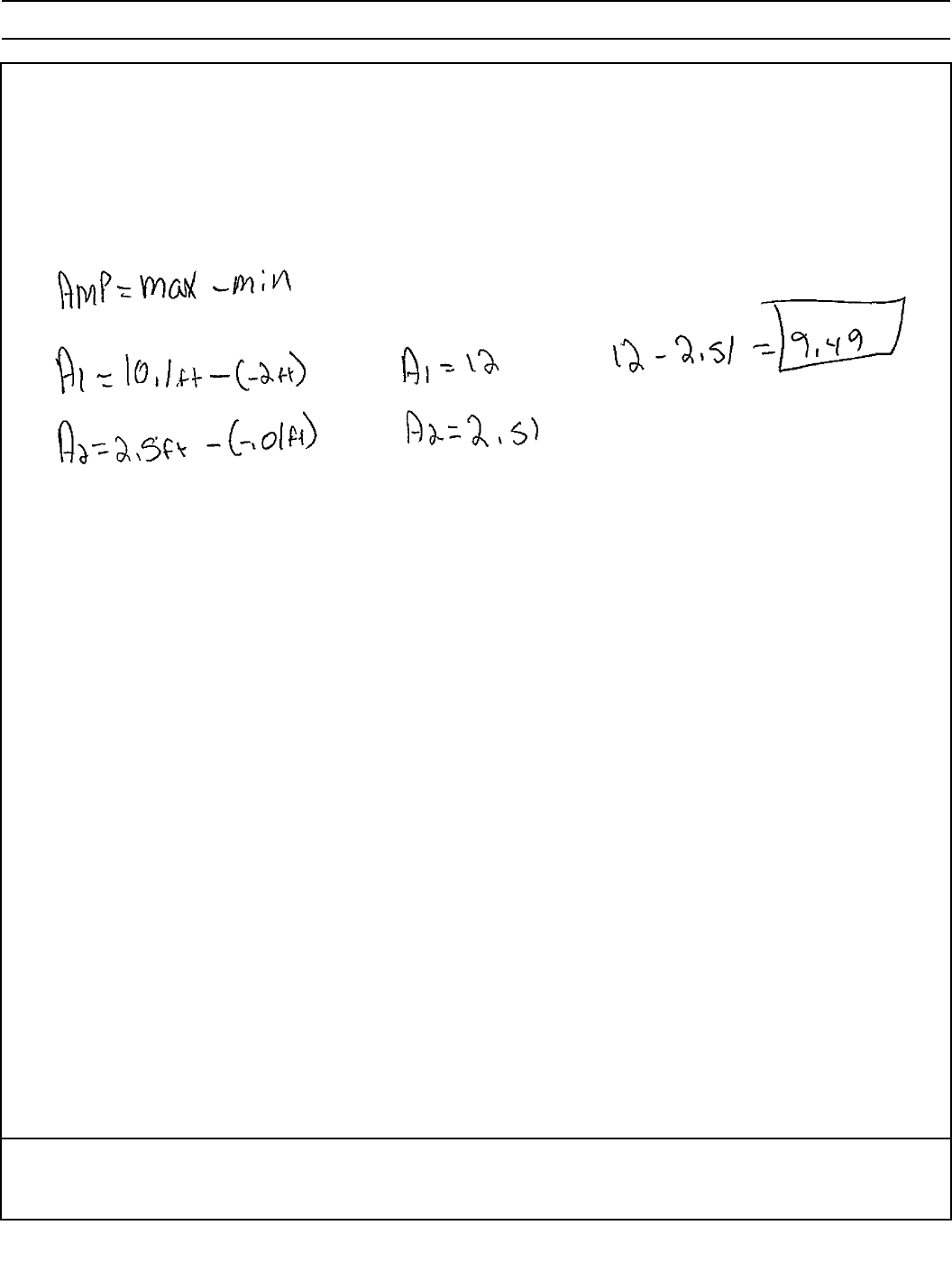
Algebra II – Aug. ’19 [27]
Question 30
Score 0: The student made multiple errors.
30 On July 21, 2016, the water level in Puget Sound, WA reached a high of 10.1 ft at 6 a.m. and
a low of ⫺2 ft at 12:30 p.m. Across the country in Long Island, NY, Shinnecock Bay’s water level
reached a high of 2.5 ft at 10:42 p.m. and a low of ⫺0.1 ft at 5:31 a.m.
The water levels of both locations are affected by the tides and can be modeled by sinusoidal
functions. Determine the difference in amplitudes, in feet, for these two locations.
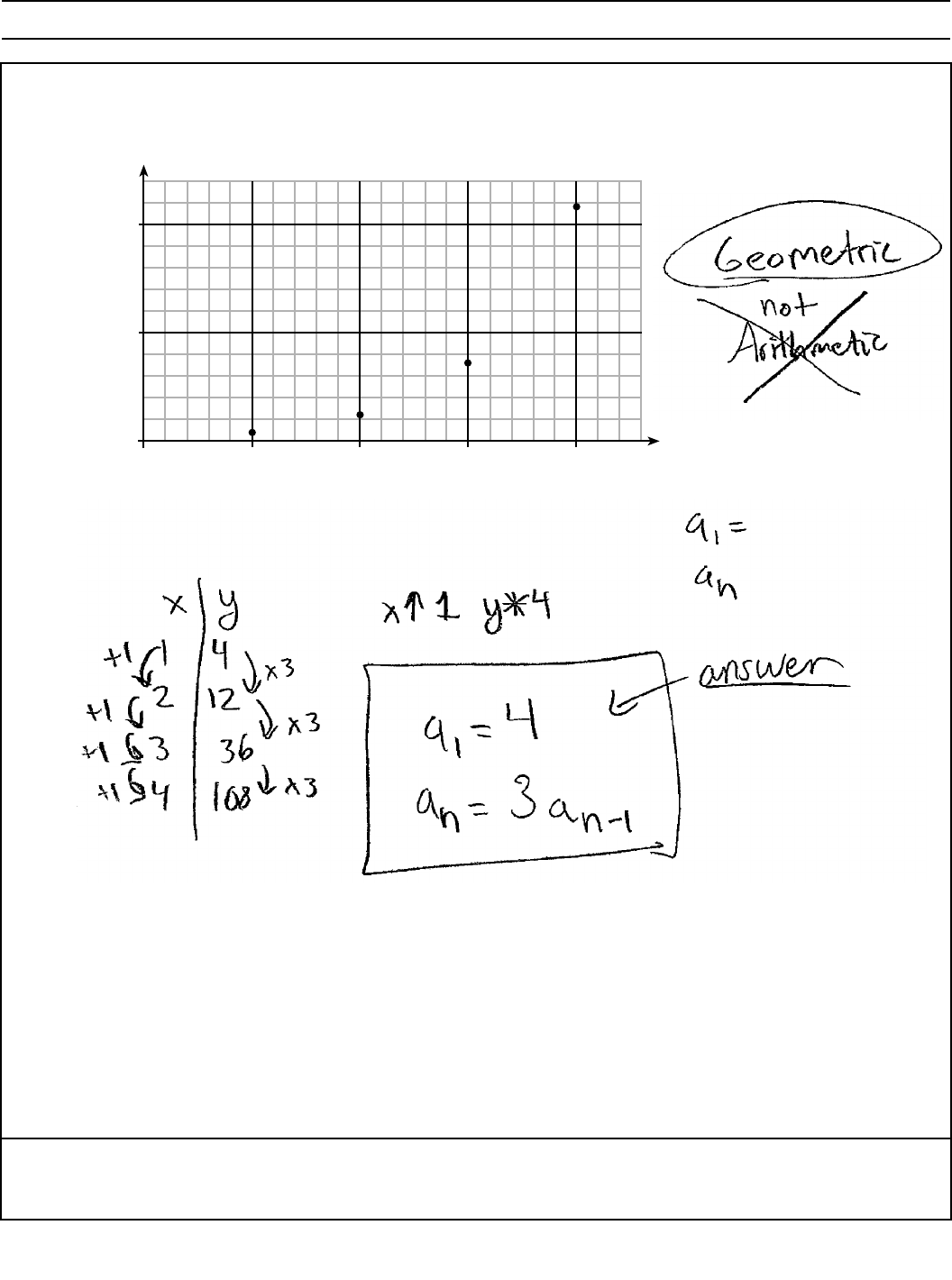
Algebra II – Aug. ’19 [28]
Question 31
Score 2: The student gave a complete and correct response.
n
10234
0
50
100
a
n
(1, 4)
(2, 12)
(3, 36)
(4, 108)
31 Write a recursive formula, a
n
, to describe the sequence graphed below.
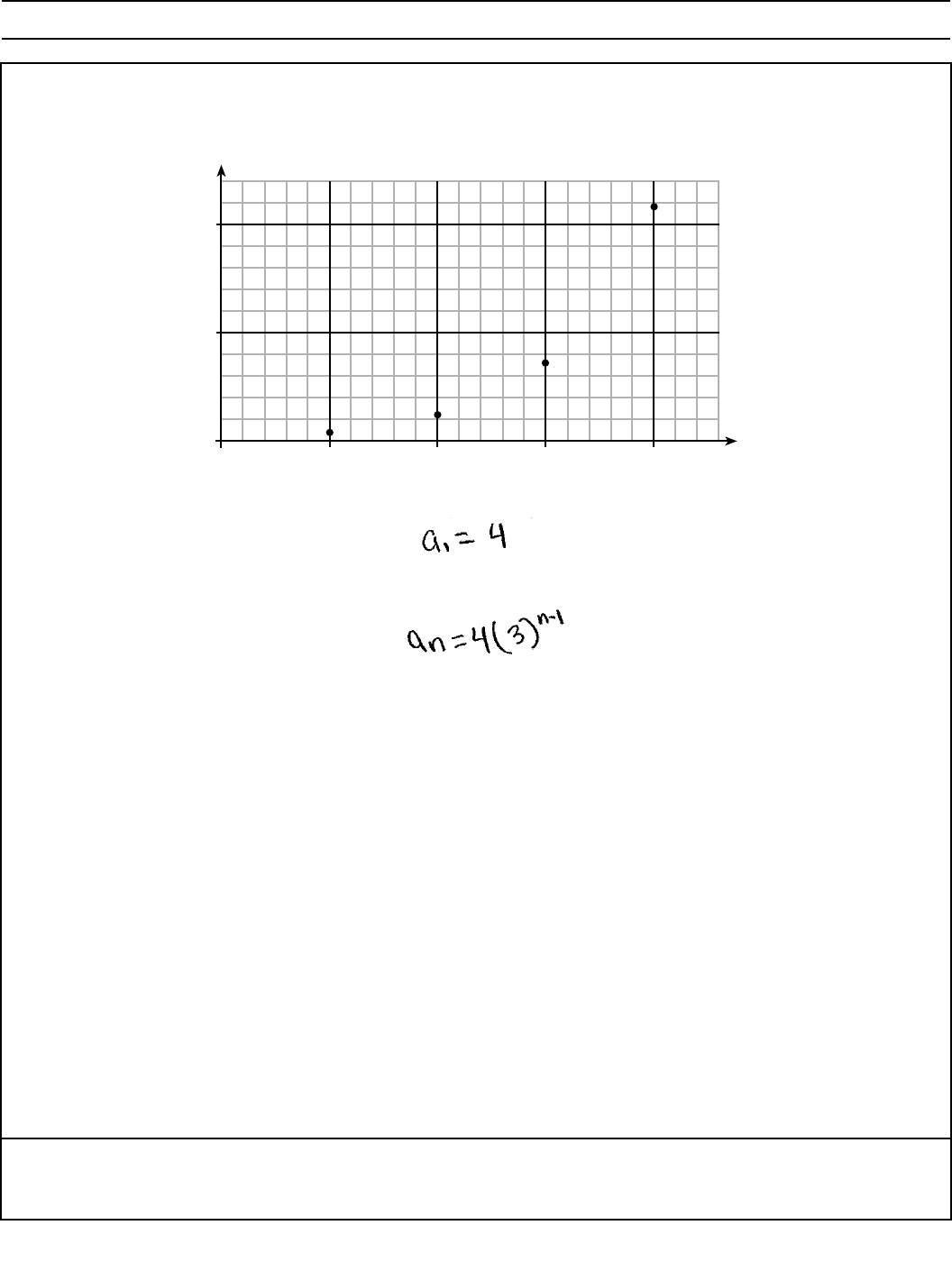
Algebra II – Aug. ’19 [29]
Question 31
Score 1: The student wrote an explicit formula.
31 Write a recursive formula, a
n
, to describe the sequence graphed below.
n
10234
0
50
100
a
n
(1, 4)
(2, 12)
(3, 36)
(4, 108)

Algebra II – Aug. ’19 [30]
Question 31
Score 1: The student made a notation error.
31 Write a recursive formula, a
n
, to describe the sequence graphed below.
n
10234
0
50
100
a
n
(1, 4)
(2, 12)
(3, 36)
(4, 108)

Algebra II – Aug. ’19 [31]
Question 31
Score 0: The student did not show enough correct work to receive any credit.
31 Write a recursive formula, a
n
, to describe the sequence graphed below.
n
10234
0
50
100
a
n
(1, 4)
(2, 12)
(3, 36)
(4, 108)
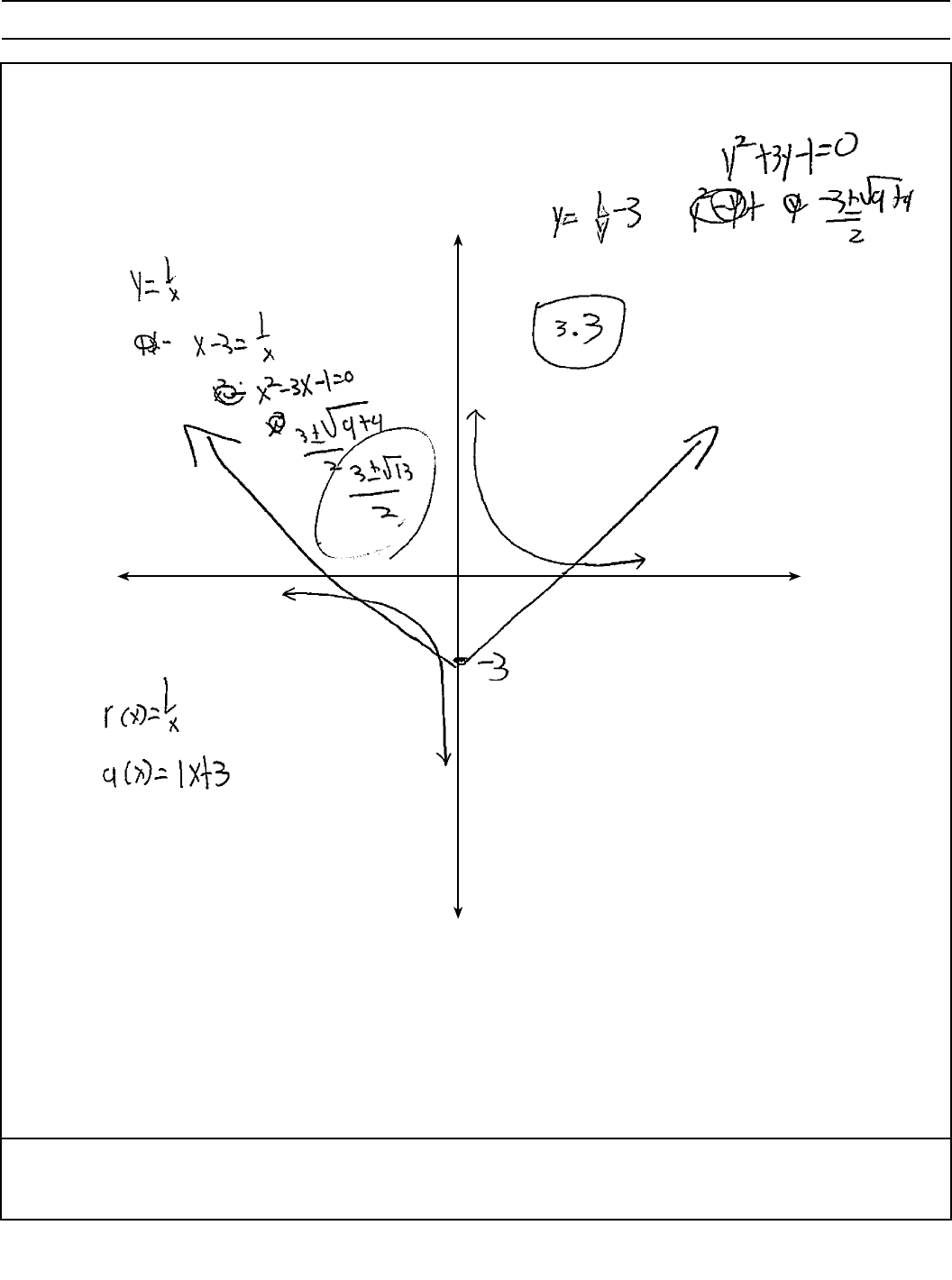
Algebra II – Aug. ’19 [32]
Question 32
Score 2: The student gave a complete and correct response.
32 Sketch the graphs of r(x) ⫽
1
__
x
and a(x) ⫽ |x| ⫺ 3 on the set of axes below. Determine, to the
nearest tenth, the positive solution of r(x) ⫽ a(x).
y
x
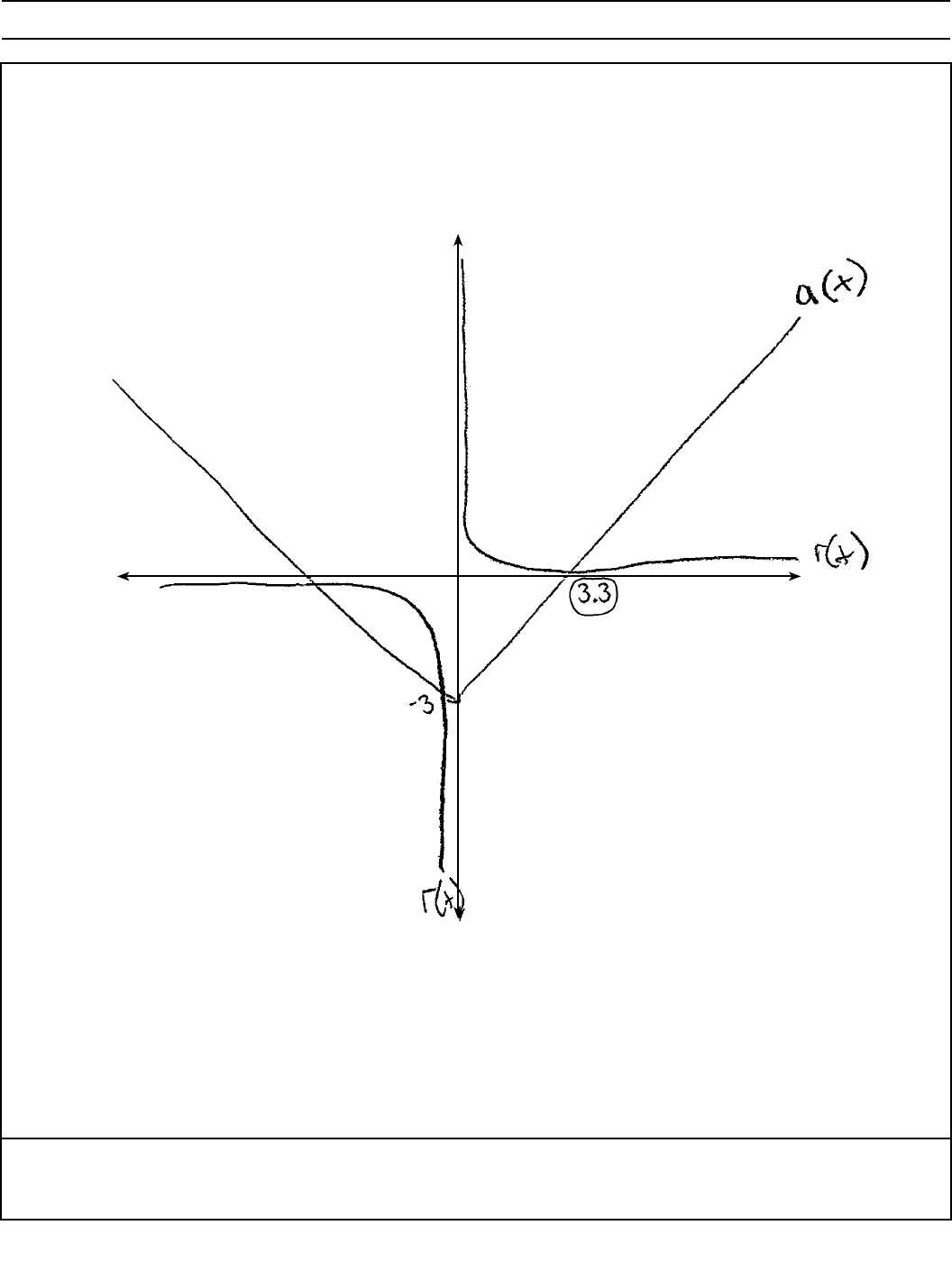
Algebra II – Aug. ’19 [33]
Question 32
Score 2: The student gave a complete and correct response.
32 Sketch the graphs of r(x) ⫽
1
__
x
and a(x) ⫽ |x| ⫺ 3 on the set of axes below. Determine, to the
nearest tenth, the positive solution of r(x) ⫽ a(x).
y
x
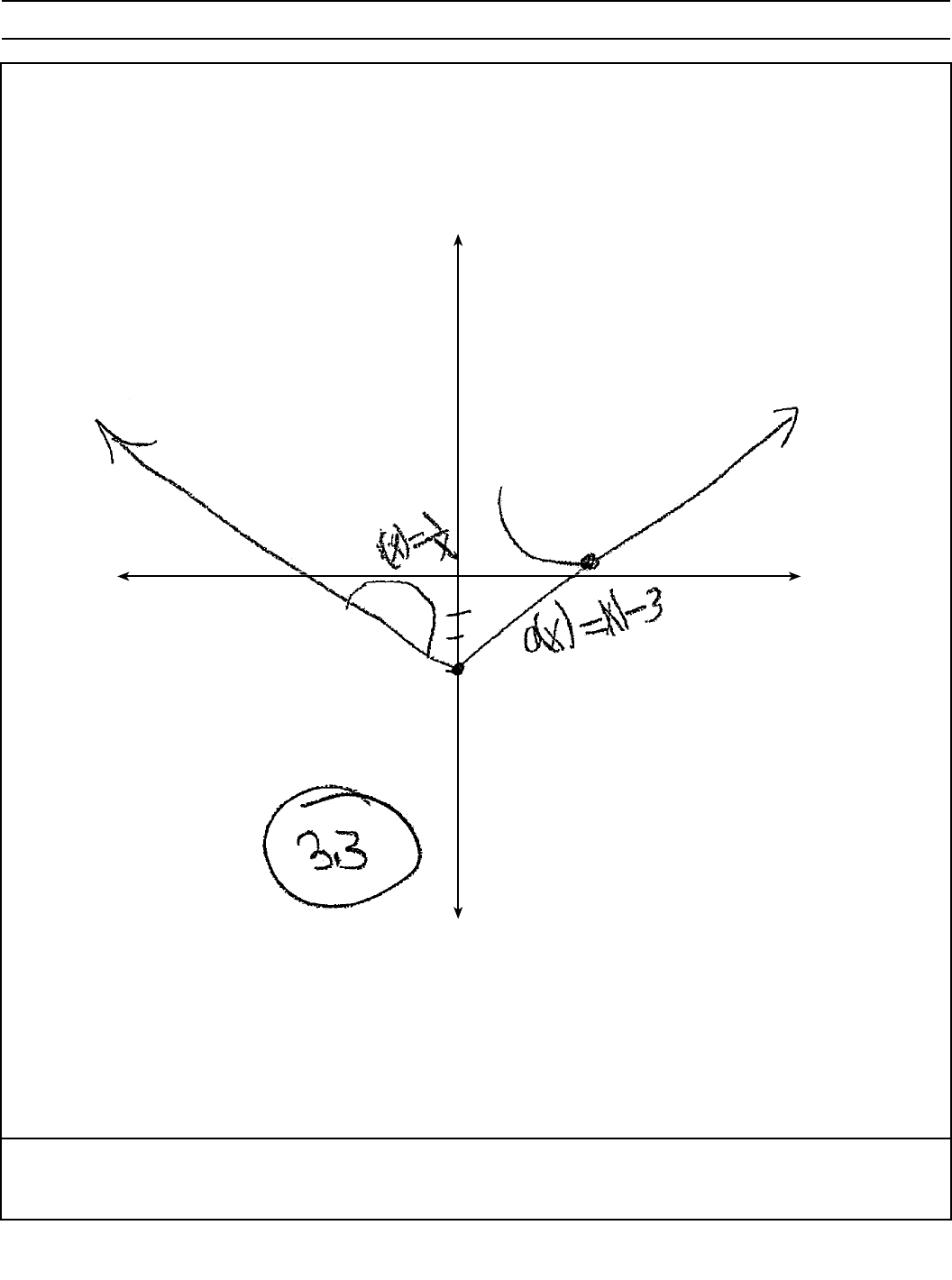
Algebra II – Aug. ’19 [34]
Question 32
Score 1: The student made an error when sketching r(x).
32 Sketch the graphs of r(x) ⫽
1
__
x
and a(x) ⫽ |x| ⫺ 3 on the set of axes below. Determine, to the
nearest tenth, the positive solution of r(x) ⫽ a(x).
y
x
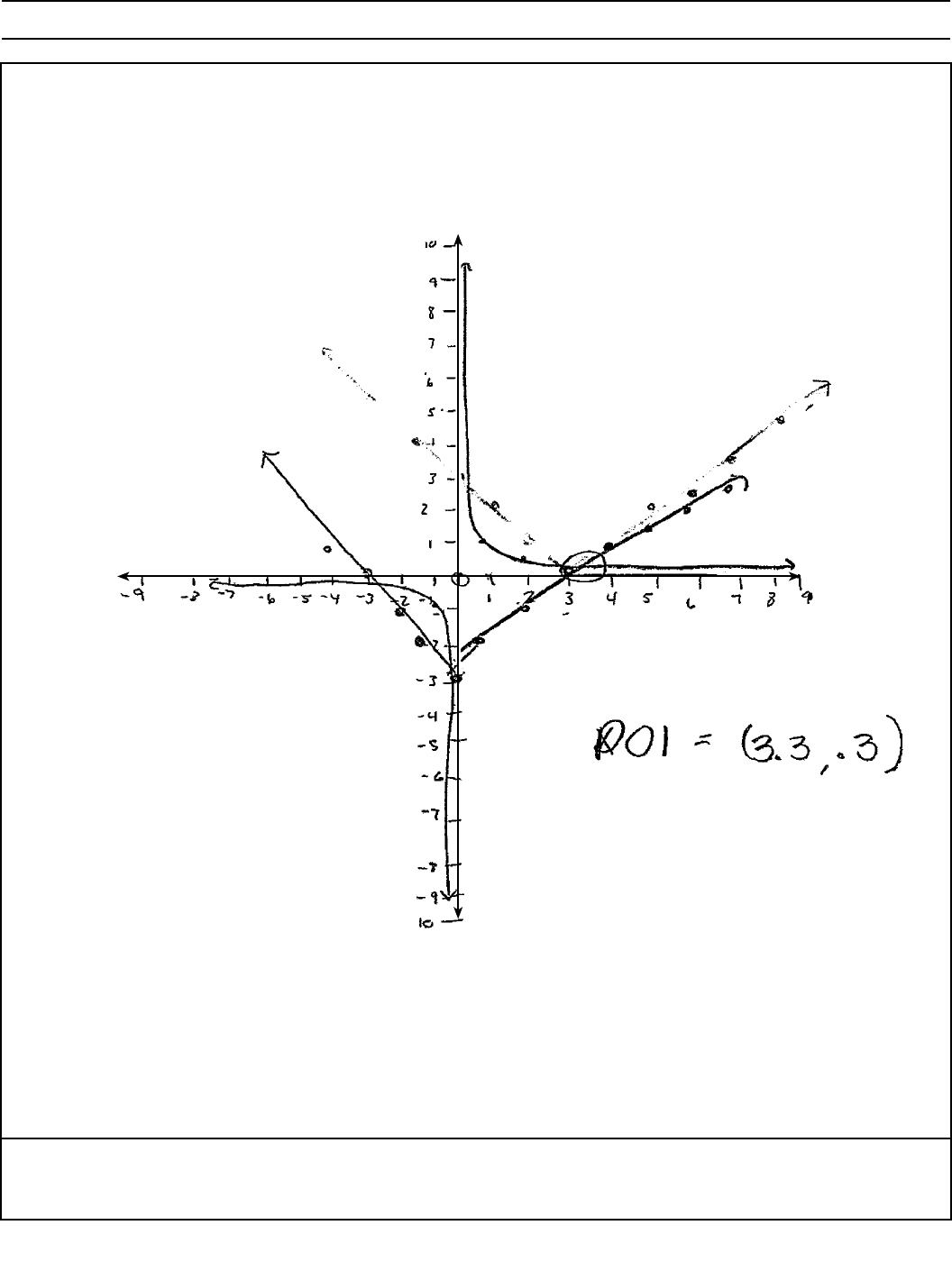
Algebra II – Aug. ’19 [35]
Question 32
Score 1: The student did not state the solution of r(x) ⫽ a(x).
32 Sketch the graphs of r(x) ⫽
1
__
x
and a(x) ⫽ |x| ⫺ 3 on the set of axes below. Determine, to the
nearest tenth, the positive solution of r(x) ⫽ a(x).
y
x

Algebra II – Aug. ’19 [36]
Question 32
Score 0: The student did not show enough correct work to receive any credit.
32 Sketch the graphs of r(x) ⫽
1
__
x
and a(x) ⫽ |x| ⫺ 3 on the set of axes below. Determine, to the
nearest tenth, the positive solution of r(x) ⫽ a(x).
y
x

Algebra II – Aug. ’19 [37]
Question 33
Score 4: The student gave a complete and correct response.
Determine the bacterial population after 36 hours, to the nearest bacterium.
33 A population of 950 bacteria grows continuously at a rate of 4.75% per day.
Write an exponential function, N(t), that represents the bacterial population after t days and
explain the reason for your choice of base.
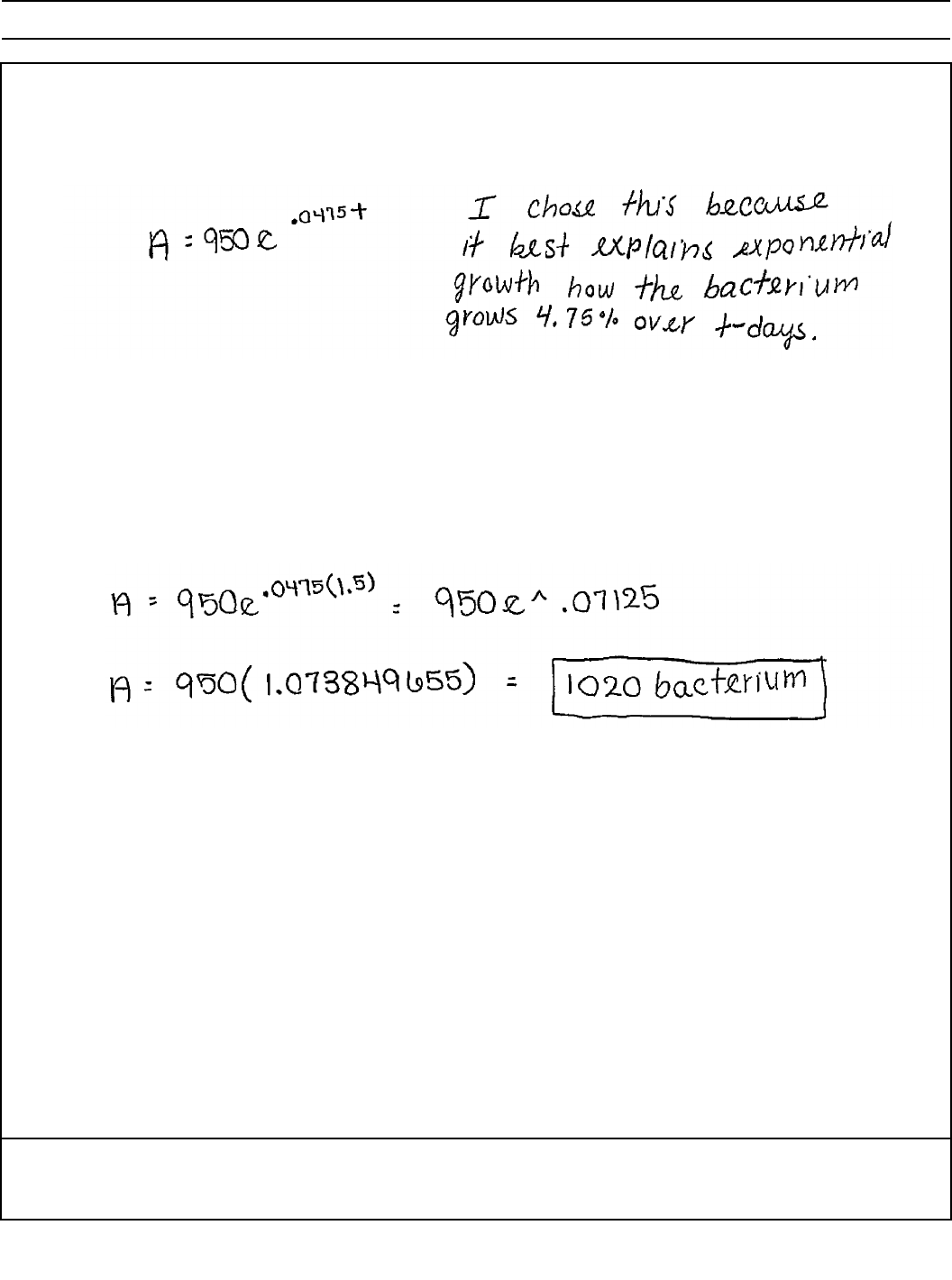
Algebra II – Aug. ’19 [38]
Question 33
Score 3: The student gave an incomplete explanation for the choice of the base.
Determine the bacterial population after 36 hours, to the nearest bacterium.
33 A population of 950 bacteria grows continuously at a rate of 4.75% per day.
Write an exponential function, N(t), that represents the bacterial population after t days and
explain the reason for your choice of base.
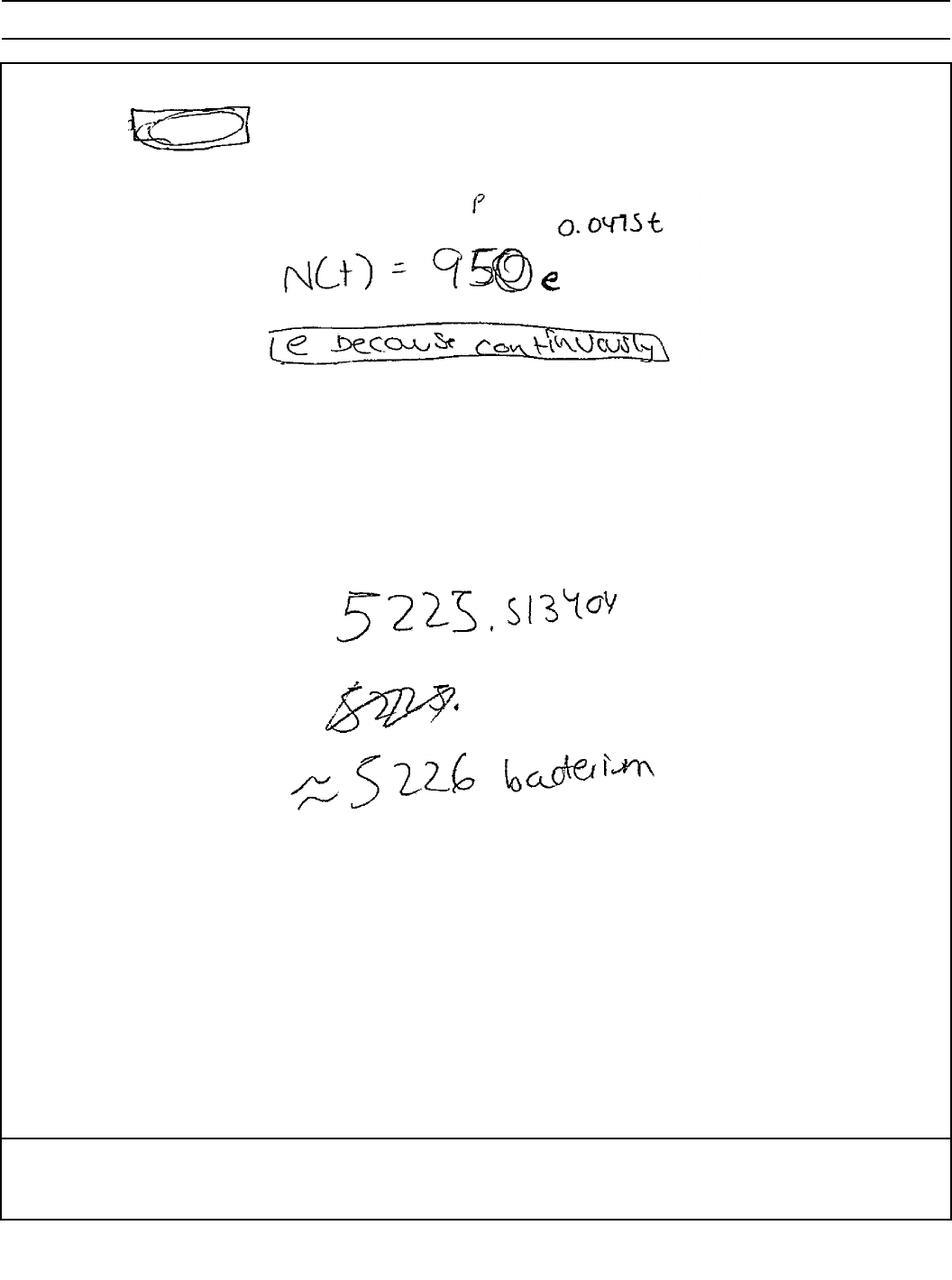
Algebra II – Aug. ’19 [39]
Question 33
Score 2: The student received full credit for the first part.
Determine the bacterial population after 36 hours, to the nearest bacterium.
33 A population of 950 bacteria grows continuously at a rate of 4.75% per day.
Write an exponential function, N(t), that represents the bacterial population after t days and
explain the reason for your choice of base.
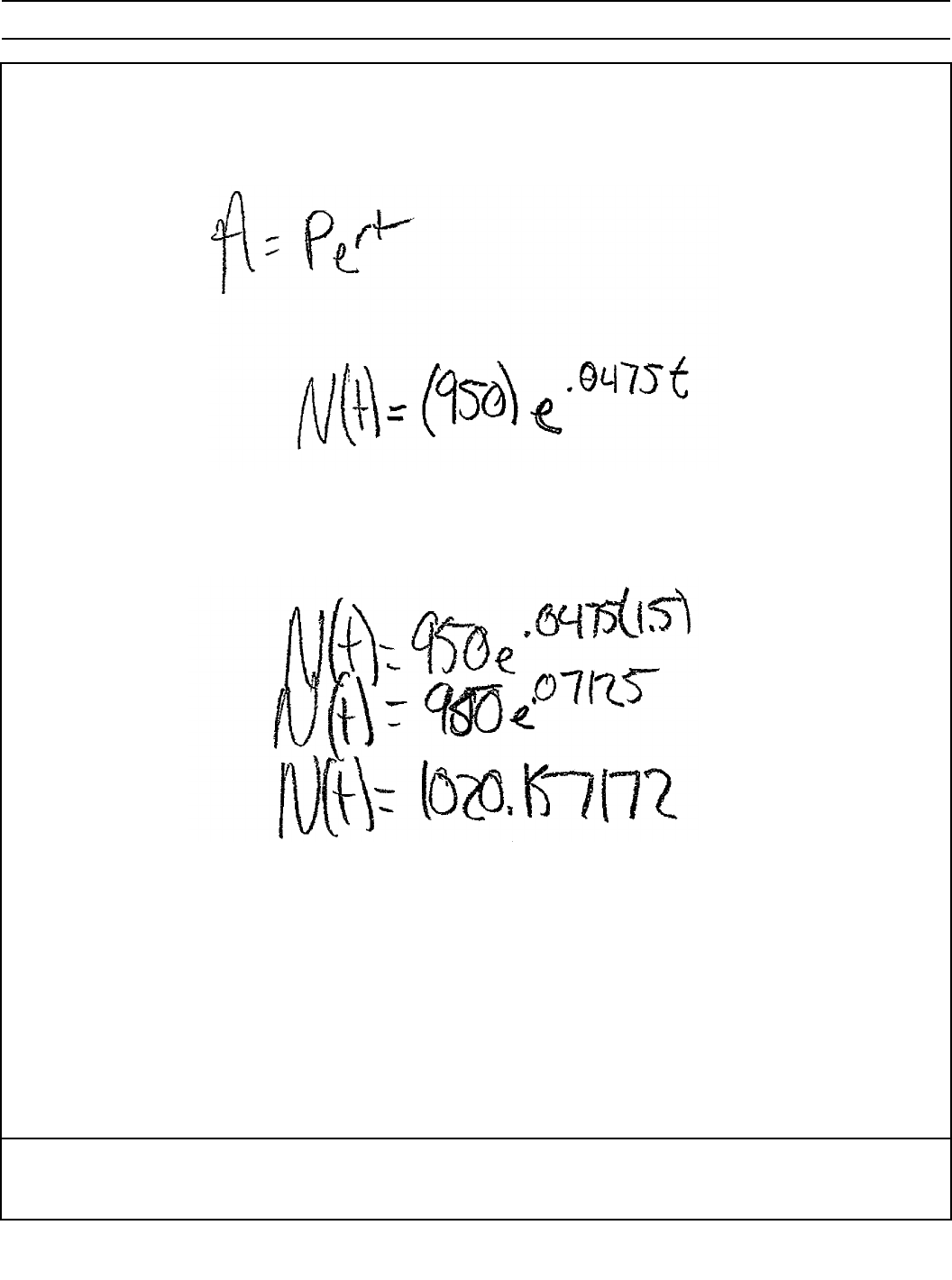
Algebra II – Aug. ’19 [40]
Question 33
Score 2: The student gave no explanation and made a rounding error in the second part.
Determine the bacterial population after 36 hours, to the nearest bacterium.
33 A population of 950 bacteria grows continuously at a rate of 4.75% per day.
Write an exponential function, N(t), that represents the bacterial population after t days and
explain the reason for your choice of base.

Algebra II – Aug. ’19 [41]
Question 33
Score 1: The student gave a correct explanation for the choice of base.
Determine the bacterial population after 36 hours, to the nearest bacterium.
33 A population of 950 bacteria grows continuously at a rate of 4.75% per day.
Write an exponential function, N(t), that represents the bacterial population after t days and
explain the reason for your choice of base.
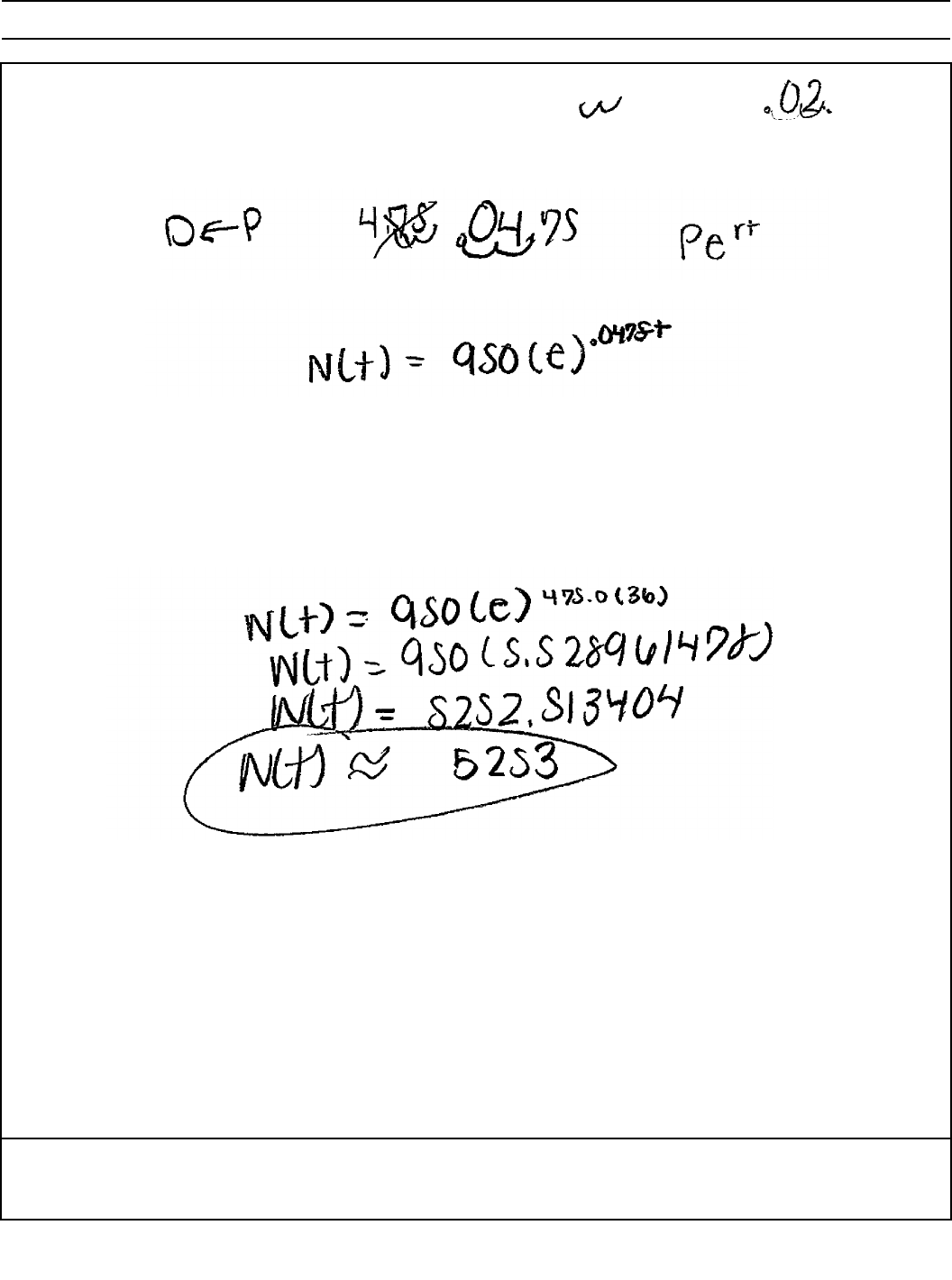
Algebra II – Aug. ’19 [42]
Question 33
Score 1: The student created a correct equation.
Determine the bacterial population after 36 hours, to the nearest bacterium.
33 A population of 950 bacteria grows continuously at a rate of 4.75% per day.
Write an exponential function, N(t), that represents the bacterial population after t days and
explain the reason for your choice of base.
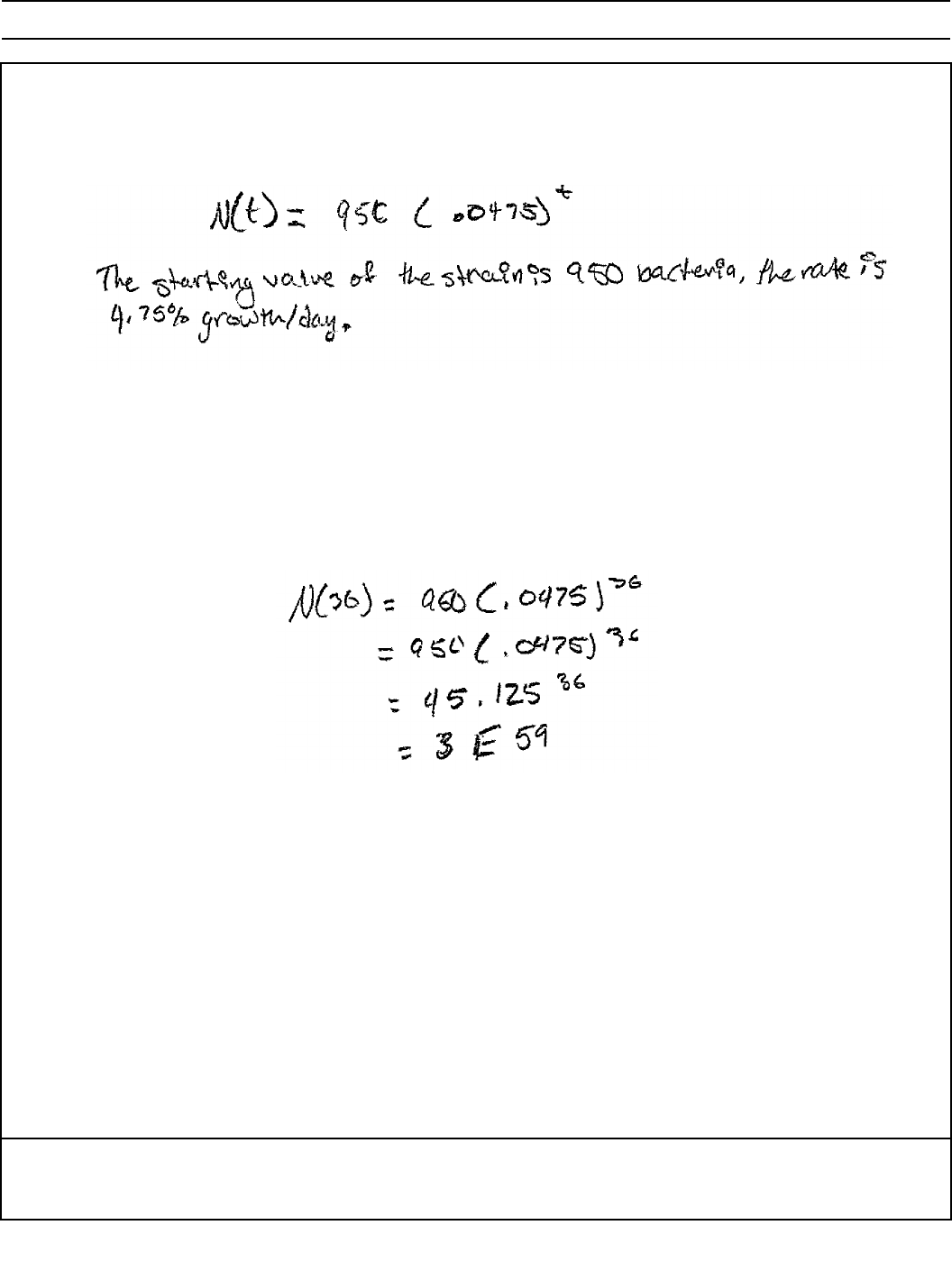
Algebra II – Aug. ’19 [43]
Question 33
Score 0: The student did not show enough correct work to receive any credit.
Determine the bacterial population after 36 hours, to the nearest bacterium.
33 A population of 950 bacteria grows continuously at a rate of 4.75% per day.
Write an exponential function, N(t), that represents the bacterial population after t days and
explain the reason for your choice of base.

Algebra II – Aug. ’19 [44]
Question 34
Score 4: The student gave a complete and correct response.
34 Write an equation for a sine function with an amplitude of 2 and a period of
π
__
2
.
On the grid below, sketch the graph of the equation in the interval 0 to 2π.

Algebra II – Aug. ’19 [45]
Question 34
Score 3: The student made a notation error writing the equation.
On the grid below, sketch the graph of the equation in the interval 0 to 2π.
34 Write an equation for a sine function with an amplitude of 2 and a period of
π
__
2
.

Algebra II – Aug. ’19 [46]
Question 34
Score 2: The student sketched a correct graph.
On the grid below, sketch the graph of the equation in the interval 0 to 2π.
34 Write an equation for a sine function with an amplitude of 2 and a period of
π
__
2
.

Algebra II – Aug. ’19 [47]
Question 34
Score 1: The student received one credit for the sketch.
On the grid below, sketch the graph of the equation in the interval 0 to 2π.
34 Write an equation for a sine function with an amplitude of 2 and a period of
π
__
2
.

Algebra II – Aug. ’19 [48]
Question 34
Score 0: The student did not show enough correct work to receive any credit.
On the grid below, sketch the graph of the equation in the interval 0 to 2π.
34 Write an equation for a sine function with an amplitude of 2 and a period of
π
__
2
.

Algebra II – Aug. ’19 [49]
Question 35
Score 4: The student gave a complete and correct response.
Based on the simulation, is it unusual that Mary’s pack had 14 red candies out of a total of 60?
Explain.
35 Mary bought a pack of candy. The manufacturer claims that 30% of the candies manufactured
are red. In her pack, 14 of the 60 candies are red. She ran a simulation of 300 samples, assuming
the manufacturer is correct. The results are shown below.
Based on the simulation, determine the middle 95% of plausible values that the proportion of
red candies in a pack is within.
0.15
0
10
20
30
40
50
0.20 0.25 0.30 0.35
Proportion of Red Candies
0.40 0.45
Mean = 0.301
SD = 0.058
Frequency
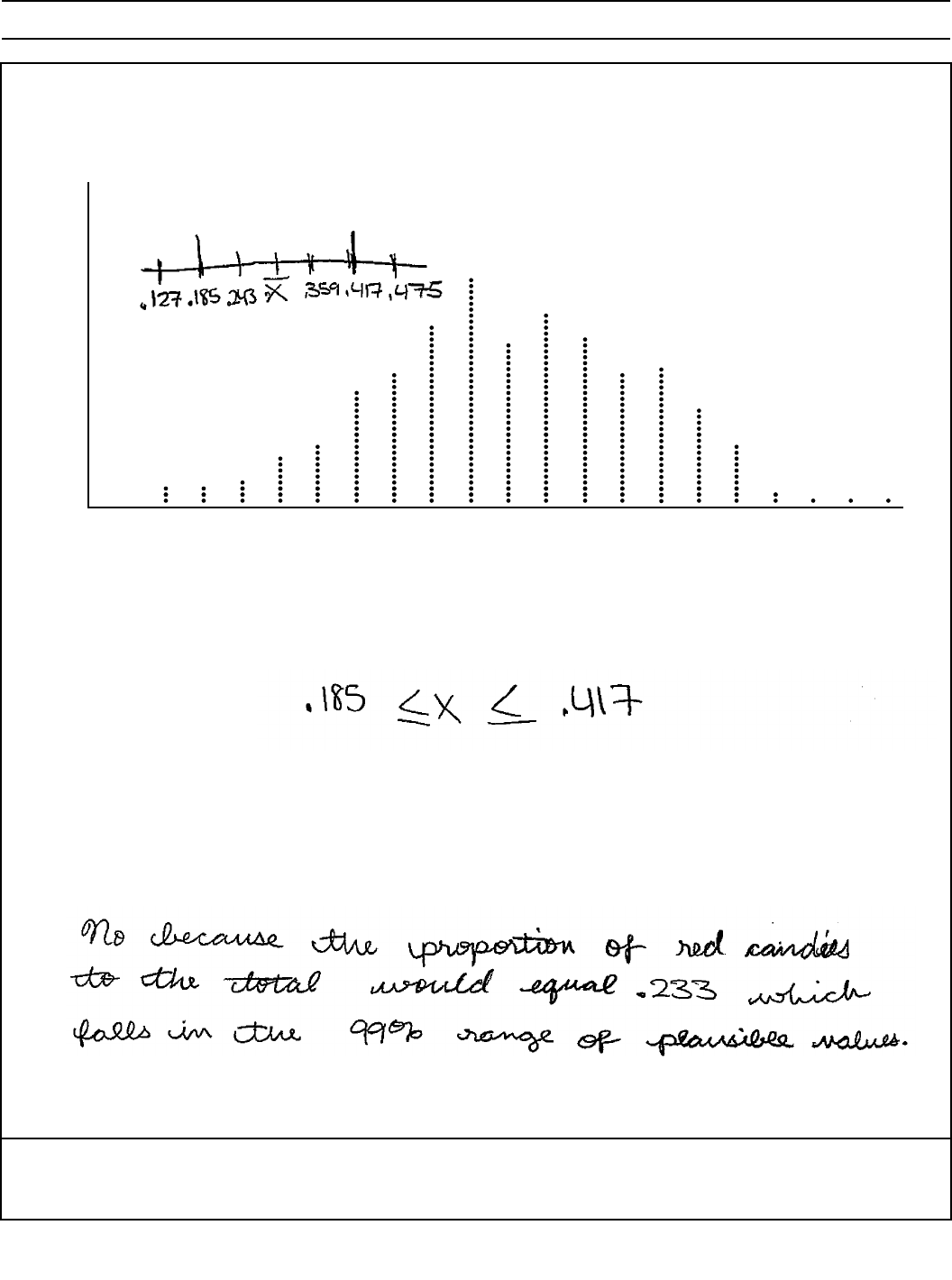
Algebra II – Aug. ’19 [50]
Question 35
Score 3: The student made a transcription error.
Based on the simulation, is it unusual that Mary’s pack had 14 red candies out of a total of 60?
Explain.
35 Mary bought a pack of candy. The manufacturer claims that 30% of the candies manufactured
are red. In her pack, 14 of the 60 candies are red. She ran a simulation of 300 samples, assuming
the manufacturer is correct. The results are shown below.
Based on the simulation, determine the middle 95% of plausible values that the proportion of
red candies in a pack is within.
0.15
0
10
20
30
40
50
0.20 0.25 0.30 0.35
Proportion of Red Candies
0.40 0.45
Mean = 0.301
SD = 0.058
Frequency

Algebra II – Aug. ’19 [51]
Question 35
Score 3: The student did not explicitly state an interval.
Based on the simulation, is it unusual that Mary’s pack had 14 red candies out of a total of 60?
Explain.
35 Mary bought a pack of candy. The manufacturer claims that 30% of the candies manufactured
are red. In her pack, 14 of the 60 candies are red. She ran a simulation of 300 samples, assuming
the manufacturer is correct. The results are shown below.
Based on the simulation, determine the middle 95% of plausible values that the proportion of
red candies in a pack is within.
0.15
0
10
20
30
40
50
0.20 0.25 0.30 0.35
Proportion of Red Candies
0.40 0.45
Mean = 0.301
SD = 0.058
Frequency
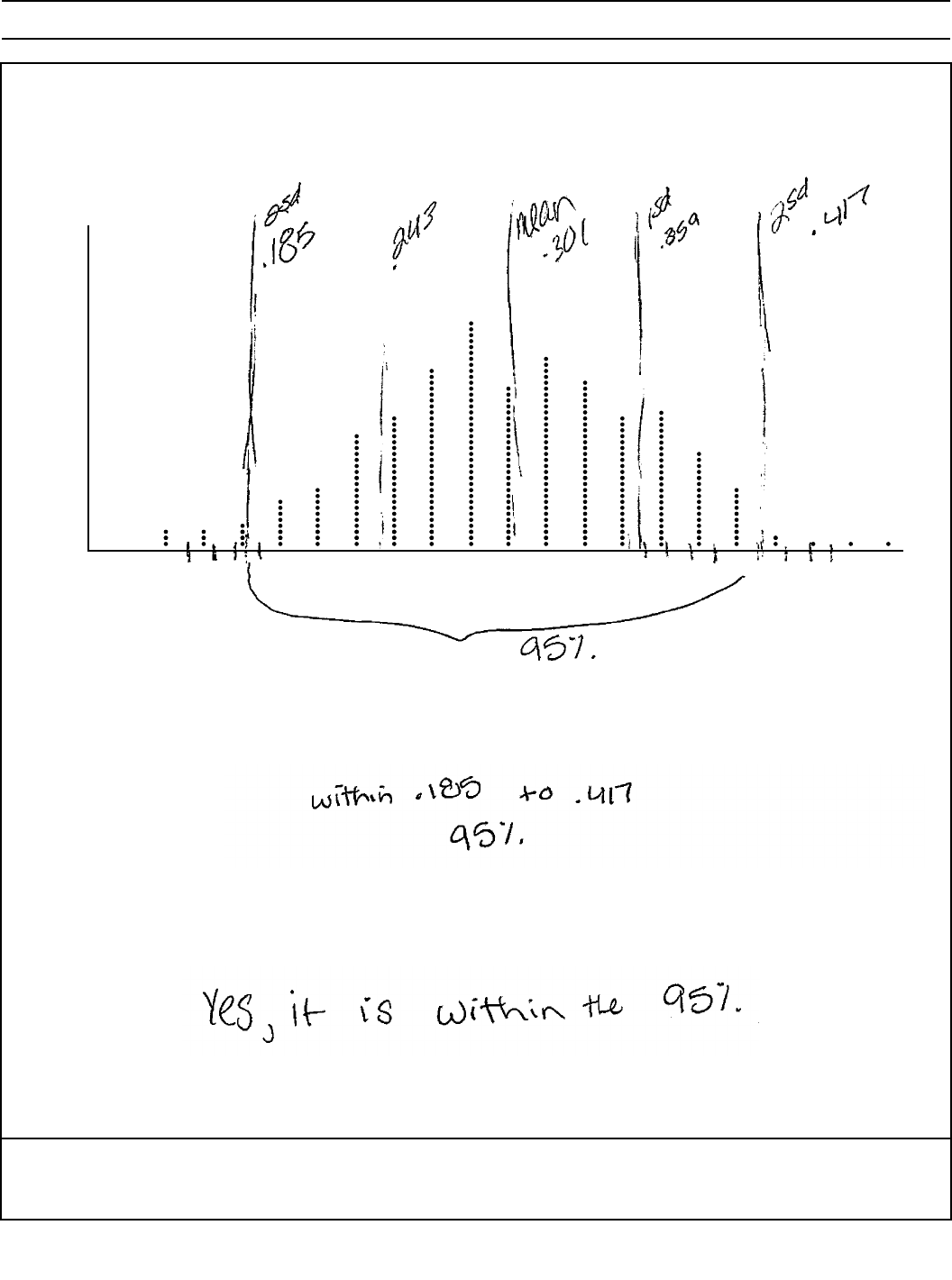
Algebra II – Aug. ’19 [52]
Question 35
Score 2: The student answered the first part correctly.
Based on the simulation, is it unusual that Mary’s pack had 14 red candies out of a total of 60?
Explain.
35 Mary bought a pack of candy. The manufacturer claims that 30% of the candies manufactured
are red. In her pack, 14 of the 60 candies are red. She ran a simulation of 300 samples, assuming
the manufacturer is correct. The results are shown below.
Based on the simulation, determine the middle 95% of plausible values that the proportion of
red candies in a pack is within.
0.15
0
10
20
30
40
50
0.20 0.25 0.30 0.35
Proportion of Red Candies
0.40 0.45
Mean = 0.301
SD = 0.058
Frequency

Algebra II – Aug. ’19 [53]
Question 35
Score 1: The student found the correct proportion.
Based on the simulation, is it unusual that Mary’s pack had 14 red candies out of a total of 60?
Explain.
35 Mary bought a pack of candy. The manufacturer claims that 30% of the candies manufactured
are red. In her pack, 14 of the 60 candies are red. She ran a simulation of 300 samples, assuming
the manufacturer is correct. The results are shown below.
Based on the simulation, determine the middle 95% of plausible values that the proportion of
red candies in a pack is within.
0.15
0
10
20
30
40
50
0.20 0.25 0.30 0.35
Proportion of Red Candies
0.40 0.45
Mean = 0.301
SD = 0.058
Frequency
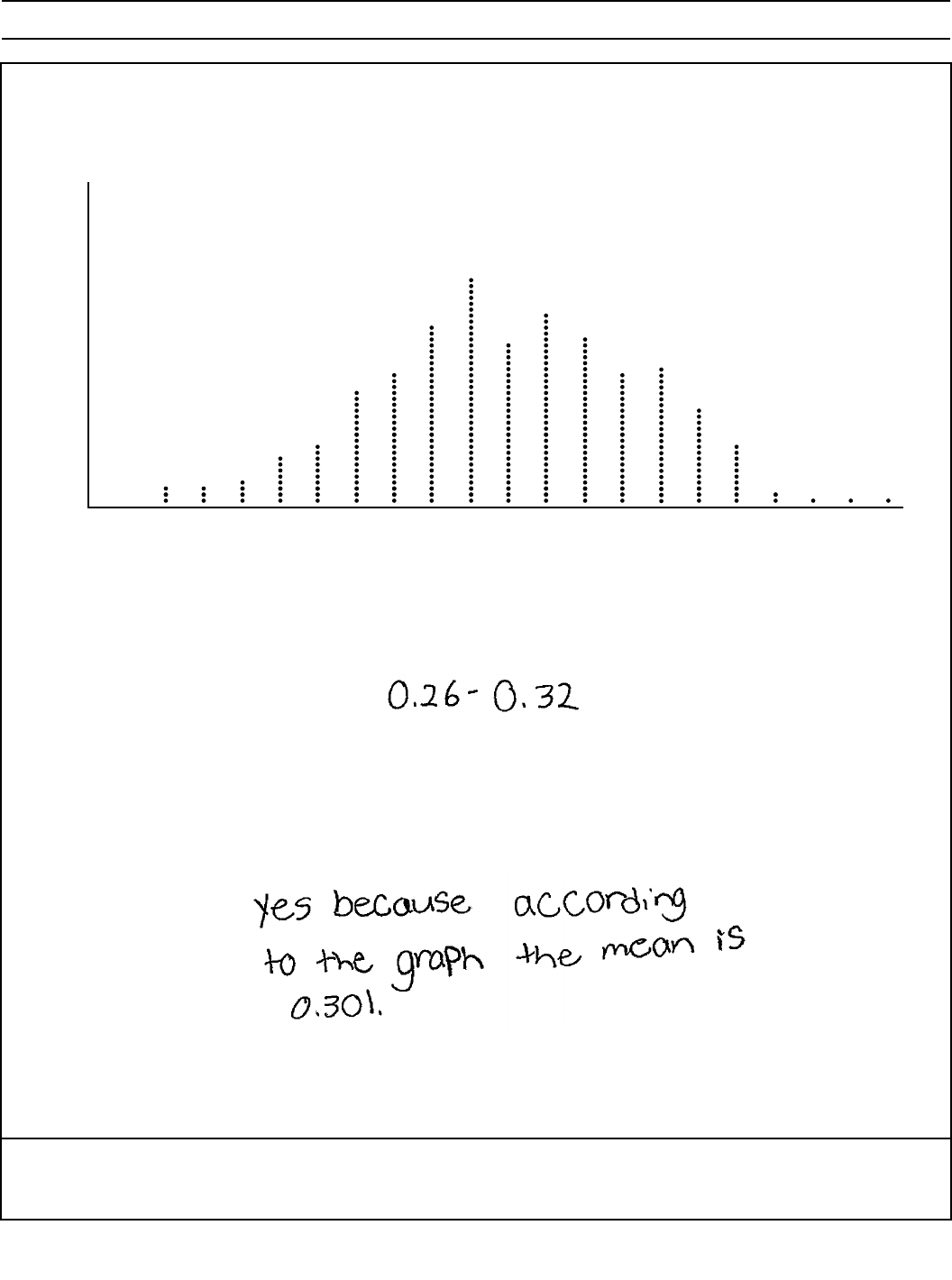
Algebra II – Aug. ’19 [54]
Question 35
Score 0: The student did not show enough correct work to receive any credit.
Based on the simulation, is it unusual that Mary’s pack had 14 red candies out of a total of 60?
Explain.
35 Mary bought a pack of candy. The manufacturer claims that 30% of the candies manufactured
are red. In her pack, 14 of the 60 candies are red. She ran a simulation of 300 samples, assuming
the manufacturer is correct. The results are shown below.
Based on the simulation, determine the middle 95% of plausible values that the proportion of
red candies in a pack is within.
0.15
0
10
20
30
40
50
0.20 0.25 0.30 0.35
Proportion of Red Candies
0.40 0.45
Mean = 0.301
SD = 0.058
Frequency
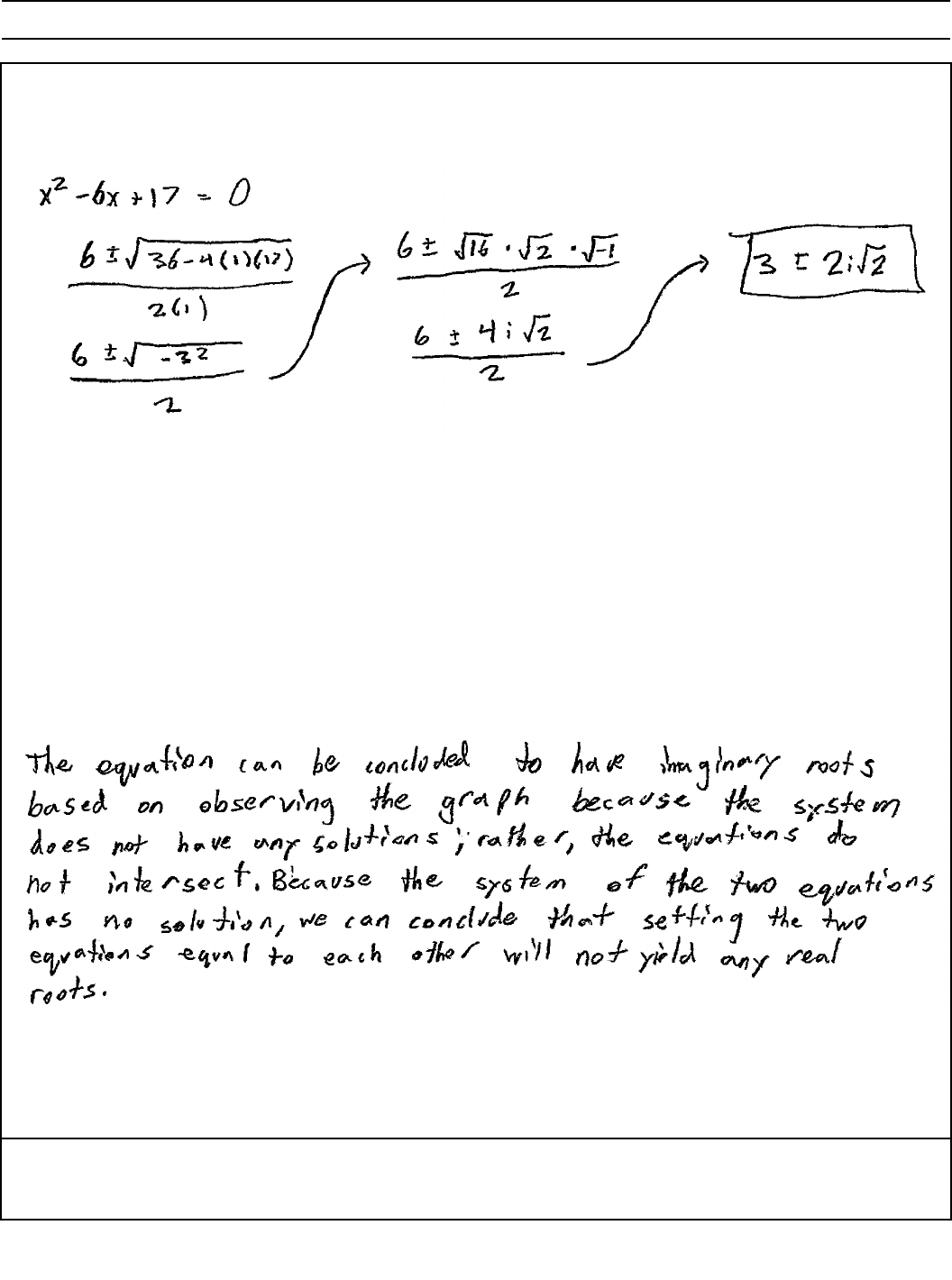
Algebra II – Aug. ’19 [55]
Question 36
Score 4: The student gave a complete and correct response.
b) Consider the system of equations below.
y ⫽ x
2
⫺ 2x ⫹ 7
y ⫽ 4x ⫺ 10
The graph of this system confirms the solution from part a is imaginary. Explain why.
36 a) Algebraically determine the roots, in simplest a ⫹ bi form, to the equation below.
x
2
⫺ 2x ⫹ 7 ⫽ 4x ⫺ 10
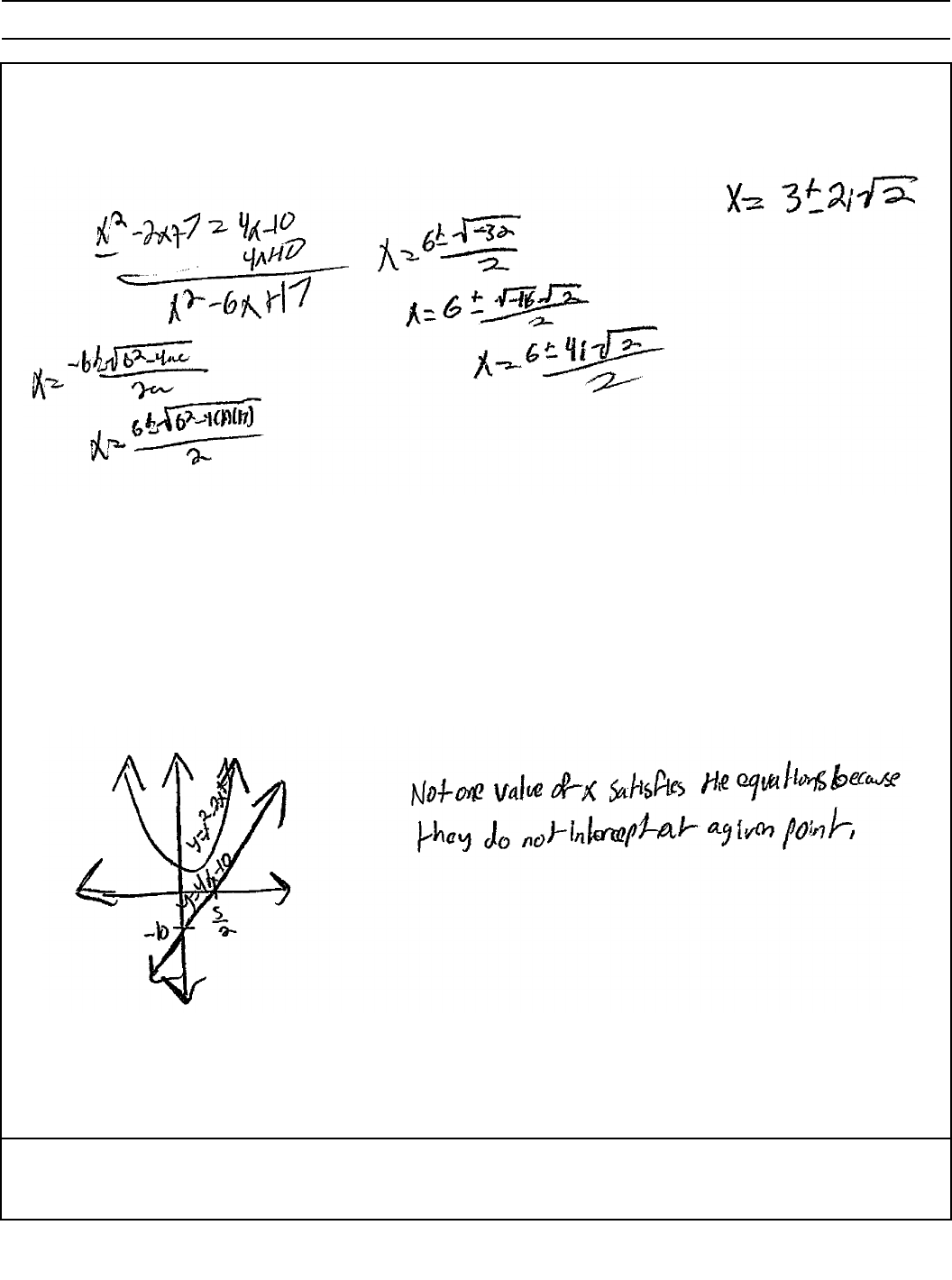
Algebra II – Aug. ’19 [56]
Question 36
Score 4: The student gave a complete and correct response.
b) Consider the system of equations below.
y ⫽ x
2
⫺ 2x ⫹ 7
y ⫽ 4x ⫺ 10
The graph of this system confirms the solution from part a is imaginary. Explain why.
36 a) Algebraically determine the roots, in simplest a ⫹ bi form, to the equation below.
x
2
⫺ 2x ⫹ 7 ⫽ 4x ⫺ 10
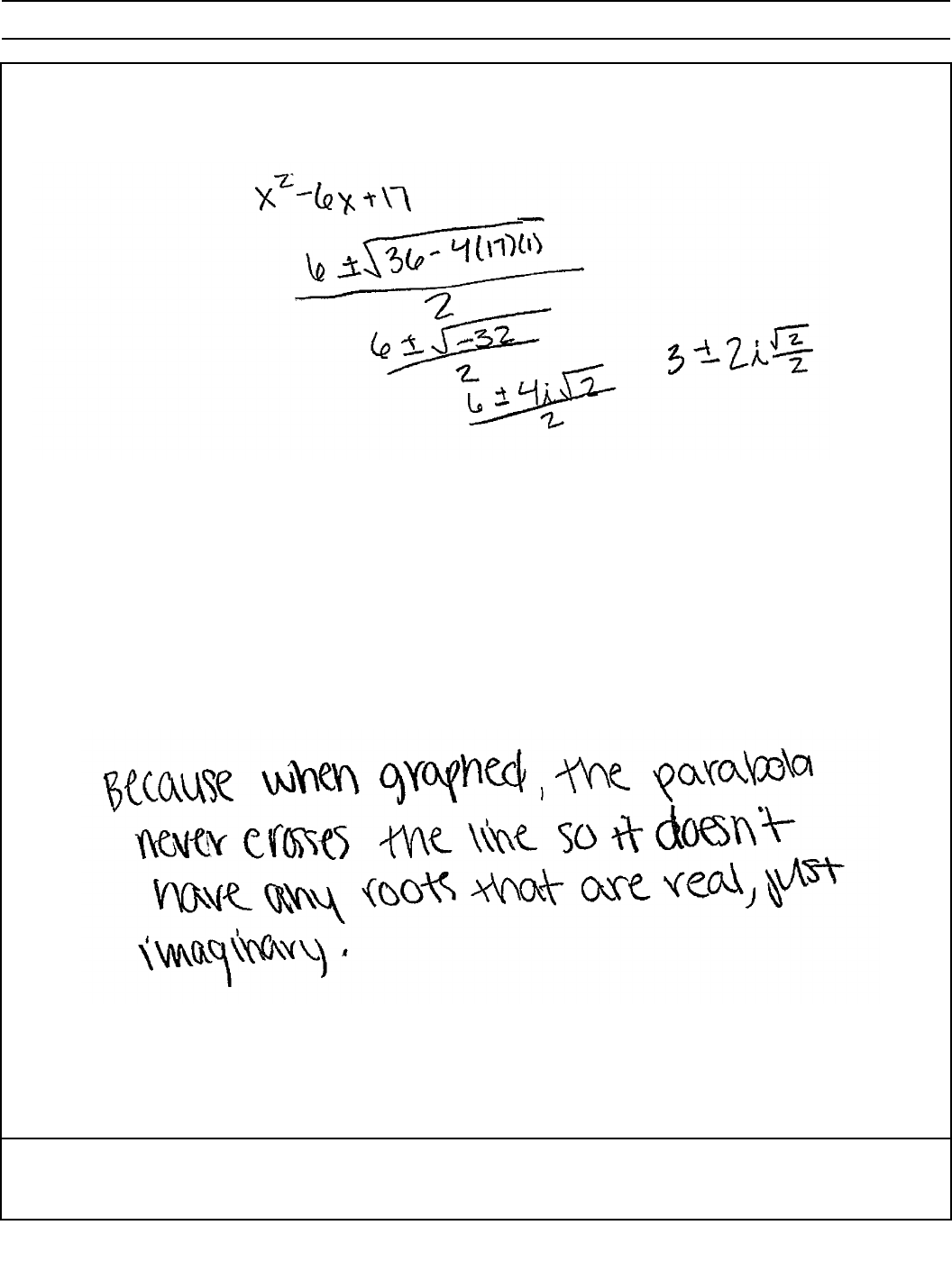
Algebra II – Aug. ’19 [57]
Question 36
Score 3: The student made a computational error.
b) Consider the system of equations below.
y ⫽ x
2
⫺ 2x ⫹ 7
y ⫽ 4x ⫺ 10
The graph of this system confirms the solution from part a is imaginary. Explain why.
36 a) Algebraically determine the roots, in simplest a ⫹ bi form, to the equation below.
x
2
⫺ 2x ⫹ 7 ⫽ 4x ⫺ 10

Algebra II – Aug. ’19 [58]
Question 36
Score 3: The student gave an incomplete explanation.
b) Consider the system of equations below.
y ⫽ x
2
⫺ 2x ⫹ 7
y ⫽ 4x ⫺ 10
The graph of this system confirms the solution from part a is imaginary. Explain why.
36 a) Algebraically determine the roots, in simplest a ⫹ bi form, to the equation below.
x
2
⫺ 2x ⫹ 7 ⫽ 4x ⫺ 10

Algebra II – Aug. ’19 [59]
Question 36
Score 2: The student gave a correct explanation.
b) Consider the system of equations below.
y ⫽ x
2
⫺ 2x ⫹ 7
y ⫽ 4x ⫺ 10
The graph of this system confirms the solution from part a is imaginary. Explain why.
36 a) Algebraically determine the roots, in simplest a ⫹ bi form, to the equation below.
x
2
⫺ 2x ⫹ 7 ⫽ 4x ⫺ 10

Algebra II – Aug. ’19 [60]
Question 36
Score 1: The student completed the square correctly.
b) Consider the system of equations below.
y ⫽ x
2
⫺ 2x ⫹ 7
y ⫽ 4x ⫺ 10
The graph of this system confirms the solution from part a is imaginary. Explain why.
36 a) Algebraically determine the roots, in simplest a ⫹ bi form, to the equation below.
x
2
⫺ 2x ⫹ 7 ⫽ 4x ⫺ 10

Algebra II – Aug. ’19 [61]
Question 36
Score 1: The student solved the quadratic equation, but did not simplify completely.
b) Consider the system of equations below.
y ⫽ x
2
⫺ 2x ⫹ 7
y ⫽ 4x ⫺ 10
The graph of this system confirms the solution from part a is imaginary. Explain why.
36 a) Algebraically determine the roots, in simplest a ⫹ bi form, to the equation below.
x
2
⫺ 2x ⫹ 7 ⫽ 4x ⫺ 10
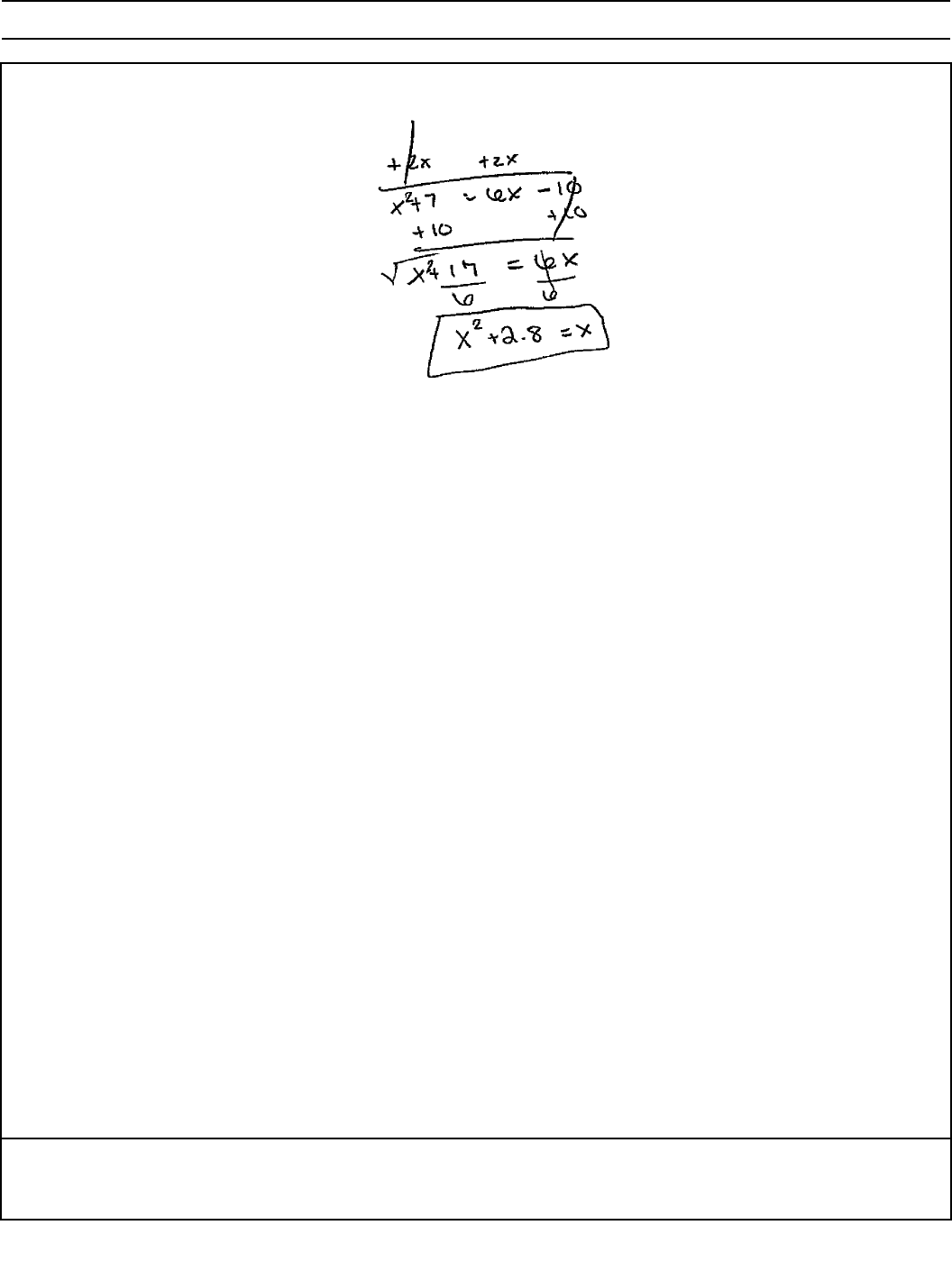
Algebra II – Aug. ’19 [62]
Question 36
Score 0: The student did not show enough correct work to receive any credit.
b) Consider the system of equations below.
y ⫽ x
2
⫺ 2x ⫹ 7
y ⫽ 4x ⫺ 10
The graph of this system confirms the solution from part a is imaginary. Explain why.
36 a) Algebraically determine the roots, in simplest a ⫹ bi form, to the equation below.
x
2
⫺ 2x ⫹ 7 ⫽ 4x ⫺ 10
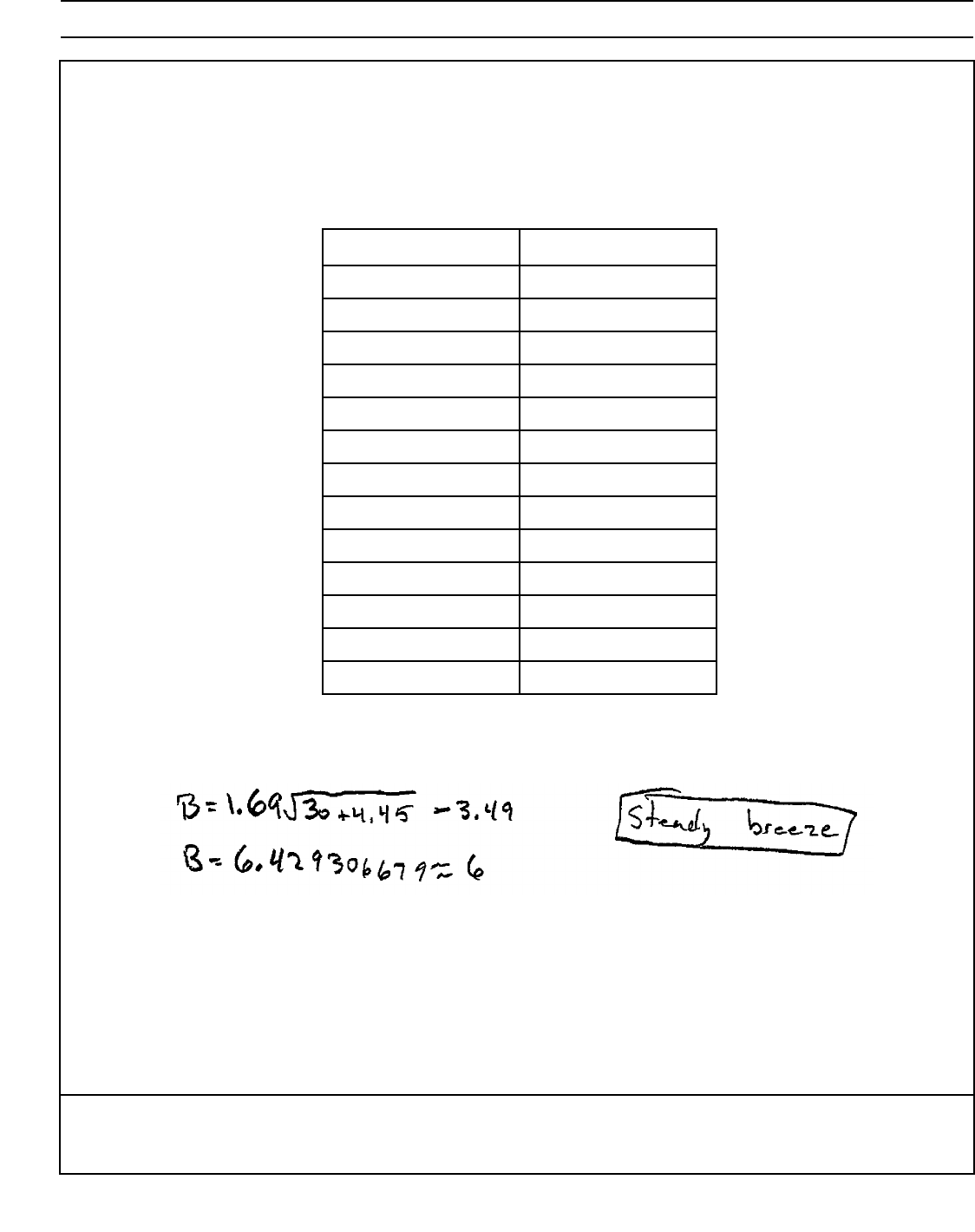
Algebra II – Aug. ’19 [63]
Question 37
Score 6: The student gave a complete and correct response.
37 The Beaufort Wind Scale was devised by British Rear Admiral Sir Francis Beaufort, in 1805 based
upon observations of the effects of the wind. Beaufort numbers, B, are determined by the
equation B ⫽ 1.69 兹苵苵苵苵苵苵苵
s ⫹ 4.45 ⫺ 3.49, where s is the speed of the wind in mph, and B is rounded
to the nearest integer from 0 to 12.
Beaufort Wind Scale
Using the table above, classify the force of wind at a speed of 30 mph. Justify your answer.
Beaufort Number Force of Wind
0 Calm
1 Light air
2 Light breeze
3 Gentle breeze
4 Moderate breeze
5 Fresh breeze
6 Steady breeze
7 Moderate gale
8 Fresh gale
9 Strong gale
10 Whole gale
11 Storm
12 Hurricane
Question 37 is continued on the next page.
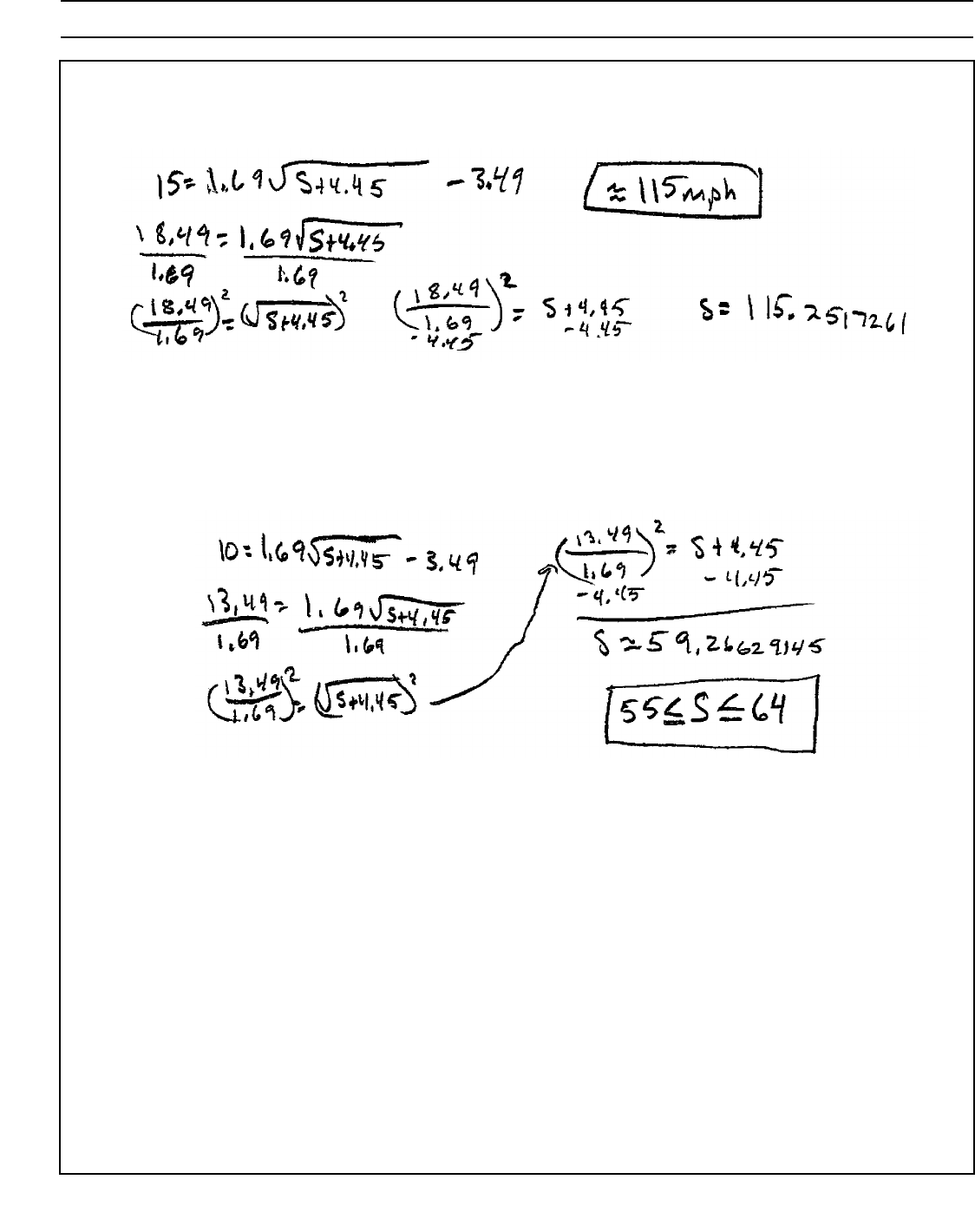
Algebra II – Aug. ’19 [64]
Question 37 continued.
In 1946, the scale was extended to accommodate strong hurricanes. A strong hurricane received
a B value of exactly 15. Algebraically determine the value of s, to the nearest mph.
Any B values that round to 10 receive a Beaufort number of 10. Using technology, find an
approximate range of wind speeds, to the nearest mph, associated with a Beaufort number of 10.
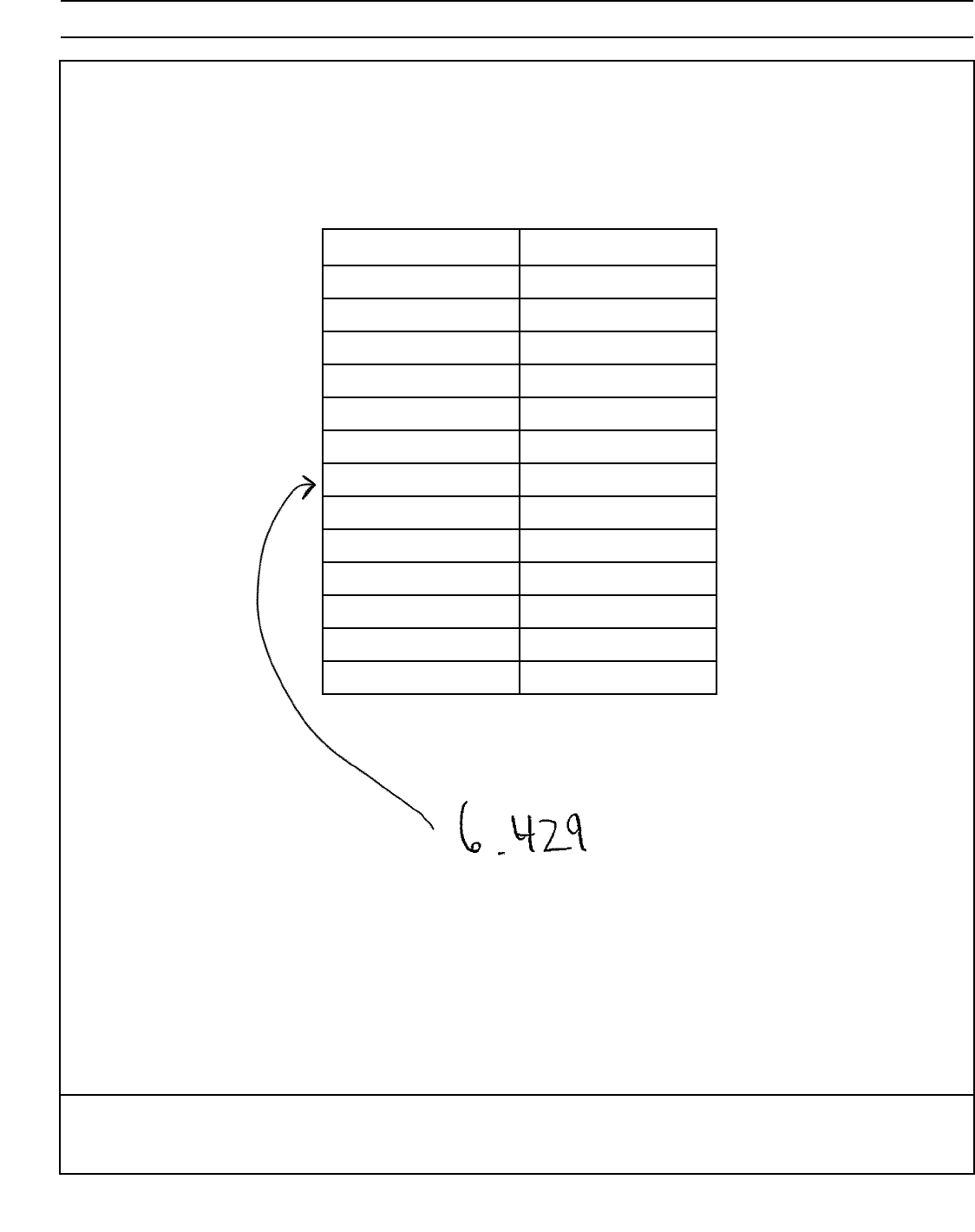
Algebra II – Aug. ’19 [65]
Question 37
Score 5: The student did not classify the force of wind.
37 The Beaufort Wind Scale was devised by British Rear Admiral Sir Francis Beaufort, in 1805 based
upon observations of the effects of the wind. Beaufort numbers, B, are determined by the
equation B ⫽ 1.69 兹苵苵苵苵苵苵苵
s ⫹ 4.45 ⫺ 3.49, where s is the speed of the wind in mph, and B is rounded
to the nearest integer from 0 to 12.
Beaufort Wind Scale
Using the table above, classify the force of wind at a speed of 30 mph. Justify your answer.
Beaufort Number Force of Wind
0 Calm
1 Light air
2 Light breeze
3 Gentle breeze
4 Moderate breeze
5 Fresh breeze
6 Steady breeze
7 Moderate gale
8 Fresh gale
9 Strong gale
10 Whole gale
11 Storm
12 Hurricane
Question 37 is continued on the next page.

Algebra II – Aug. ’19 [66]
Question 37 continued.
In 1946, the scale was extended to accommodate strong hurricanes. A strong hurricane received
a B value of exactly 15. Algebraically determine the value of s, to the nearest mph.
Any B values that round to 10 receive a Beaufort number of 10. Using technology, find an
approximate range of wind speeds, to the nearest mph, associated with a Beaufort number of 10.
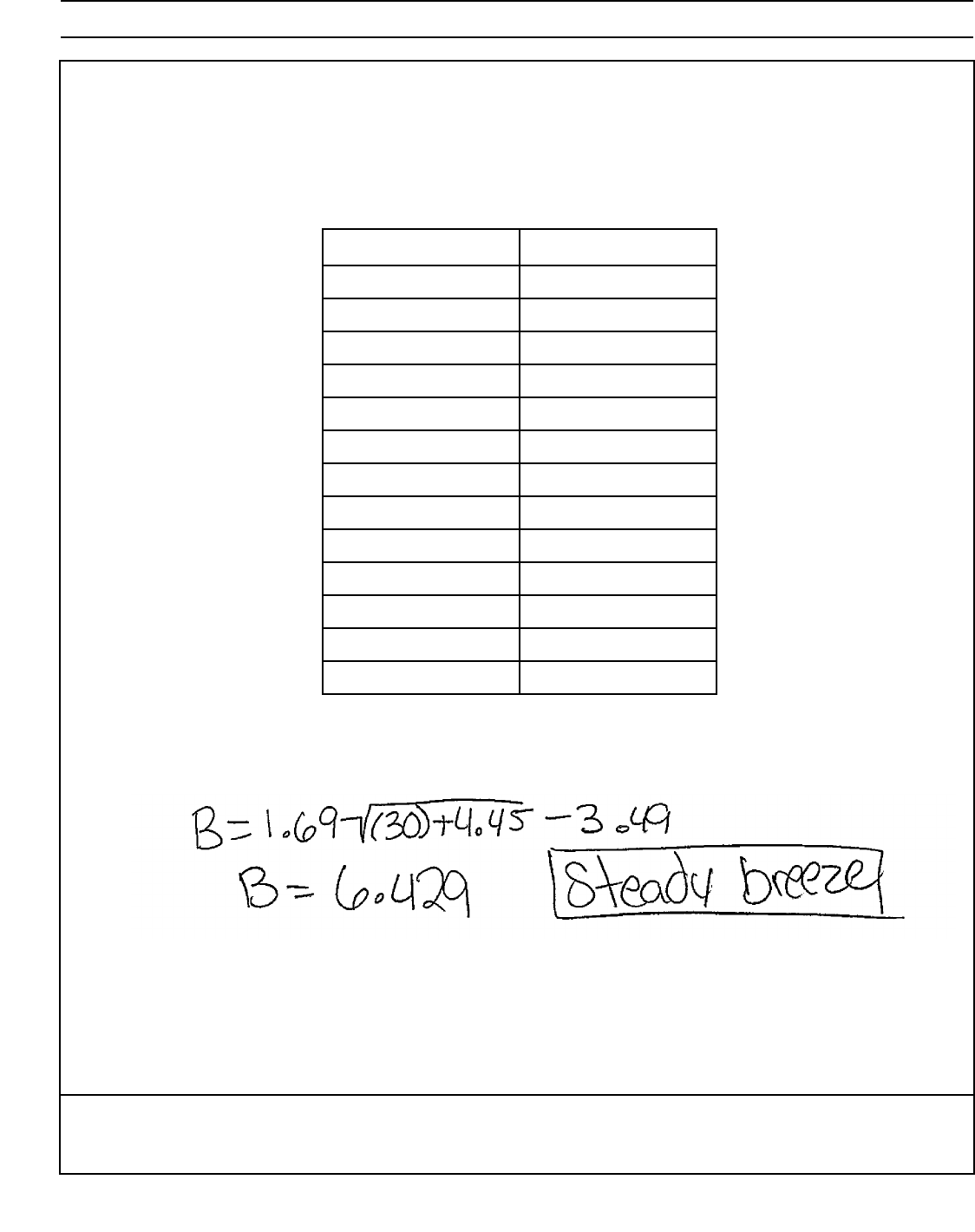
Algebra II – Aug. ’19 [67]
Question 37
Score 5: The student made an error when finding the interval.
37 The Beaufort Wind Scale was devised by British Rear Admiral Sir Francis Beaufort, in 1805 based
upon observations of the effects of the wind. Beaufort numbers, B, are determined by the
equation B ⫽ 1.69 兹苵苵苵苵苵苵苵
s ⫹ 4.45 ⫺ 3.49, where s is the speed of the wind in mph, and B is rounded
to the nearest integer from 0 to 12.
Beaufort Wind Scale
Using the table above, classify the force of wind at a speed of 30 mph. Justify your answer.
Beaufort Number Force of Wind
0 Calm
1 Light air
2 Light breeze
3 Gentle breeze
4 Moderate breeze
5 Fresh breeze
6 Steady breeze
7 Moderate gale
8 Fresh gale
9 Strong gale
10 Whole gale
11 Storm
12 Hurricane
Question 37 is continued on the next page.

Algebra II – Aug. ’19 [68]
Question 37 continued.
In 1946, the scale was extended to accommodate strong hurricanes. A strong hurricane received
a B value of exactly 15. Algebraically determine the value of s, to the nearest mph.
Any B values that round to 10 receive a Beaufort number of 10. Using technology, find an
approximate range of wind speeds, to the nearest mph, associated with a Beaufort number of 10.
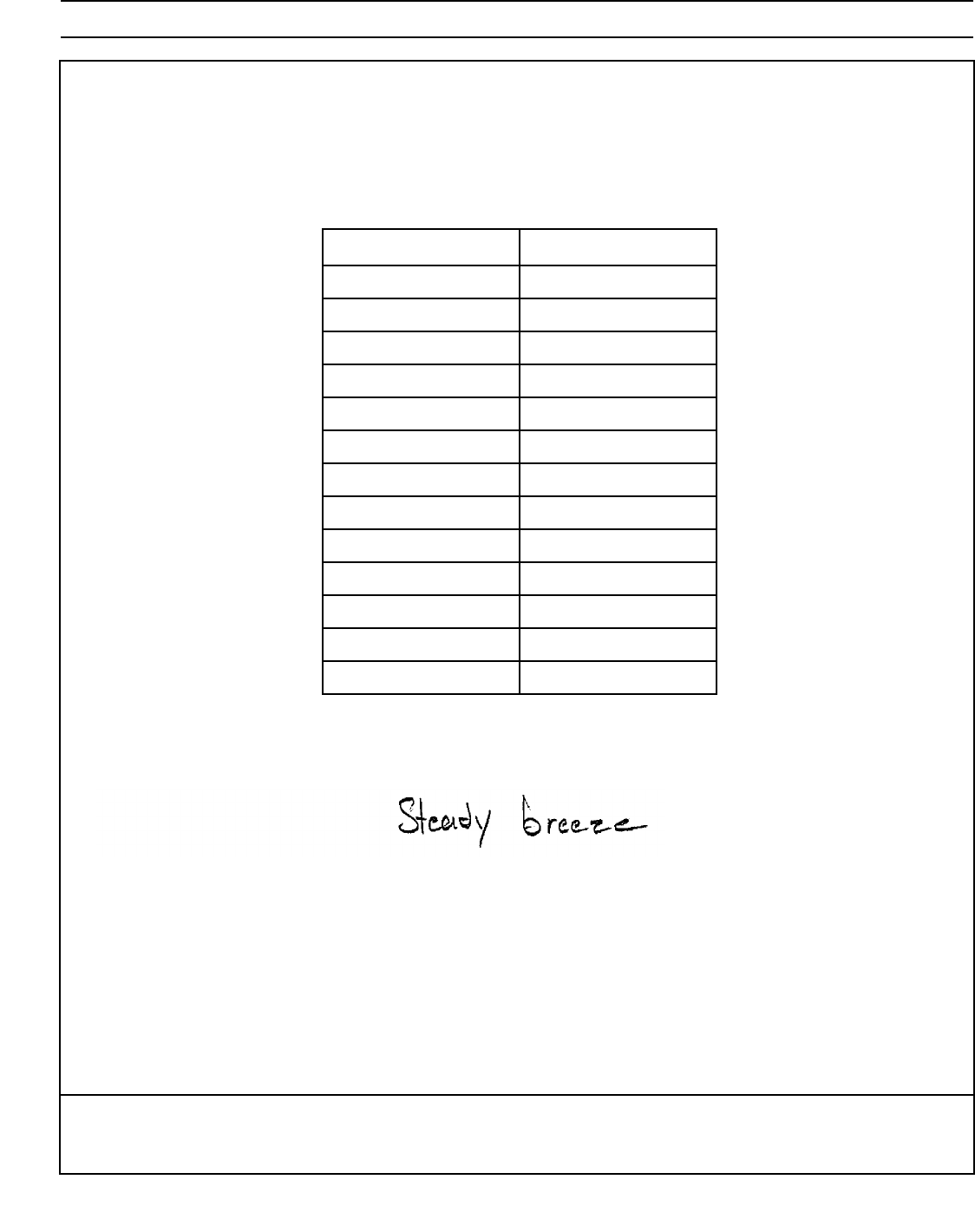
Algebra II – Aug. ’19 [69]
Question 37
Score 4: The student did not justify “steady breeze” and made an error when finding the
interval.
37 The Beaufort Wind Scale was devised by British Rear Admiral Sir Francis Beaufort, in 1805 based
upon observations of the effects of the wind. Beaufort numbers, B, are determined by the
equation B ⫽ 1.69 兹苵苵苵苵苵苵苵
s ⫹ 4.45 ⫺ 3.49, where s is the speed of the wind in mph, and B is rounded
to the nearest integer from 0 to 12.
Beaufort Wind Scale
Using the table above, classify the force of wind at a speed of 30 mph. Justify your answer.
Beaufort Number Force of Wind
0 Calm
1 Light air
2 Light breeze
3 Gentle breeze
4 Moderate breeze
5 Fresh breeze
6 Steady breeze
7 Moderate gale
8 Fresh gale
9 Strong gale
10 Whole gale
11 Storm
12 Hurricane
Question 37 is continued on the next page.
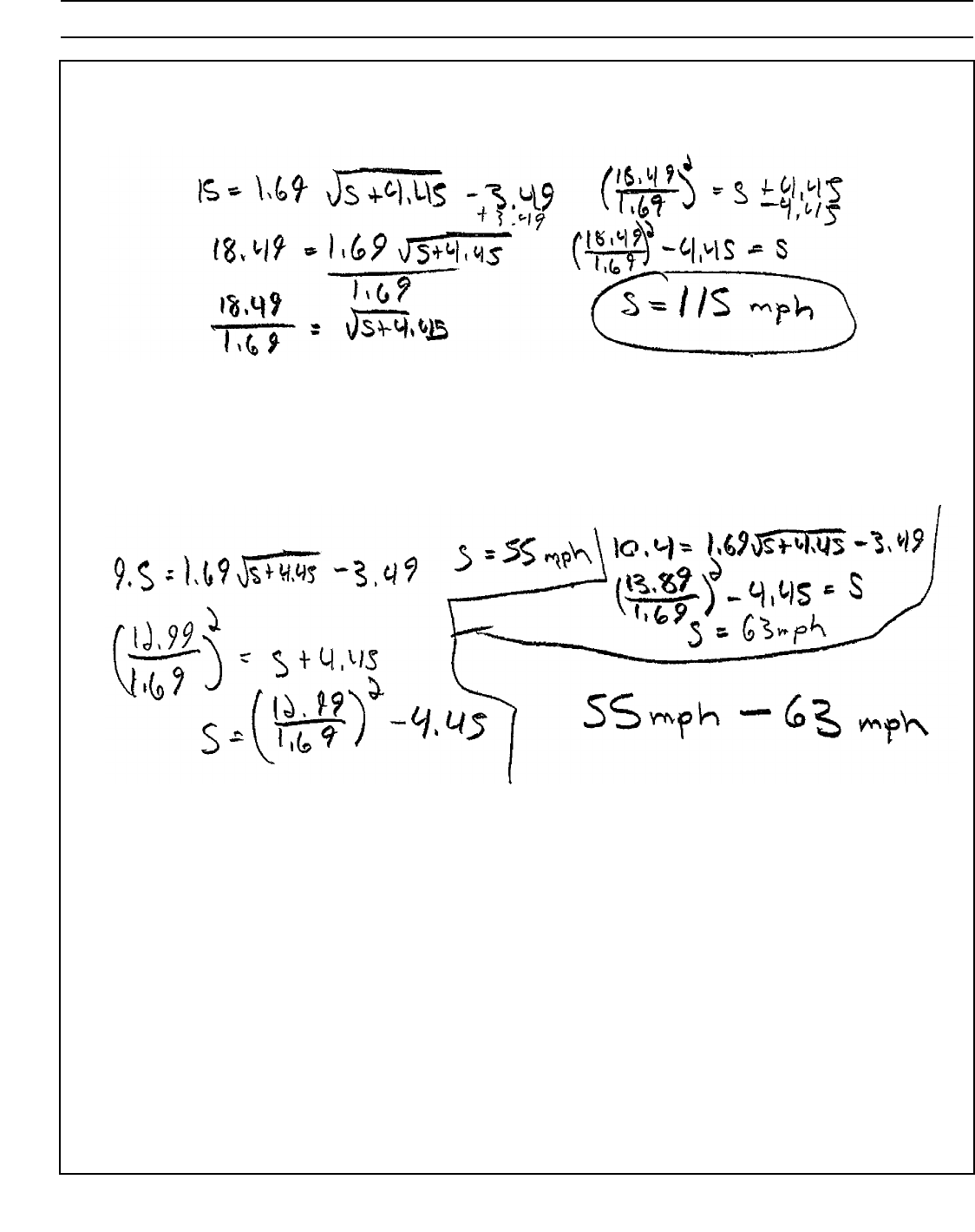
Algebra II – Aug. ’19 [70]
Question 37 continued.
In 1946, the scale was extended to accommodate strong hurricanes. A strong hurricane received
a B value of exactly 15. Algebraically determine the value of s, to the nearest mph.
Any B values that round to 10 receive a Beaufort number of 10. Using technology, find an
approximate range of wind speeds, to the nearest mph, associated with a Beaufort number of 10.
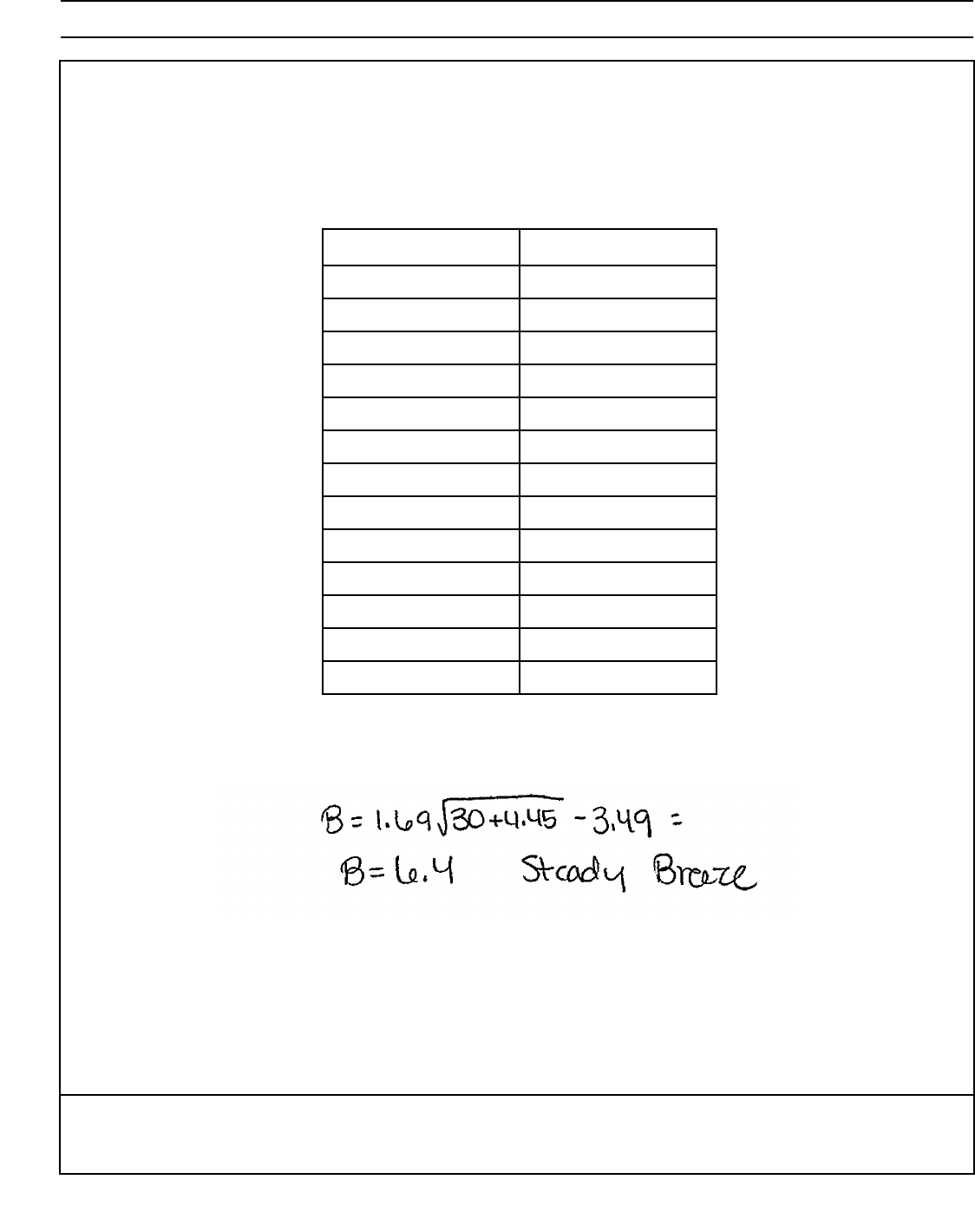
Algebra II – Aug. ’19 [71]
Question 37
Score 4: The student made a computational error and did not state an interval.
37 The Beaufort Wind Scale was devised by British Rear Admiral Sir Francis Beaufort, in 1805 based
upon observations of the effects of the wind. Beaufort numbers, B, are determined by the
equation B ⫽ 1.69 兹苵苵苵苵苵苵苵
s ⫹ 4.45 ⫺ 3.49, where s is the speed of the wind in mph, and B is rounded
to the nearest integer from 0 to 12.
Beaufort Wind Scale
Using the table above, classify the force of wind at a speed of 30 mph. Justify your answer.
Beaufort Number Force of Wind
0 Calm
1 Light air
2 Light breeze
3 Gentle breeze
4 Moderate breeze
5 Fresh breeze
6 Steady breeze
7 Moderate gale
8 Fresh gale
9 Strong gale
10 Whole gale
11 Storm
12 Hurricane
Question 37 is continued on the next page.

Algebra II – Aug. ’19 [72]
Question 37 continued.
In 1946, the scale was extended to accommodate strong hurricanes. A strong hurricane received
a B value of exactly 15. Algebraically determine the value of s, to the nearest mph.
Any B values that round to 10 receive a Beaufort number of 10. Using technology, find an
approximate range of wind speeds, to the nearest mph, associated with a Beaufort number of 10.
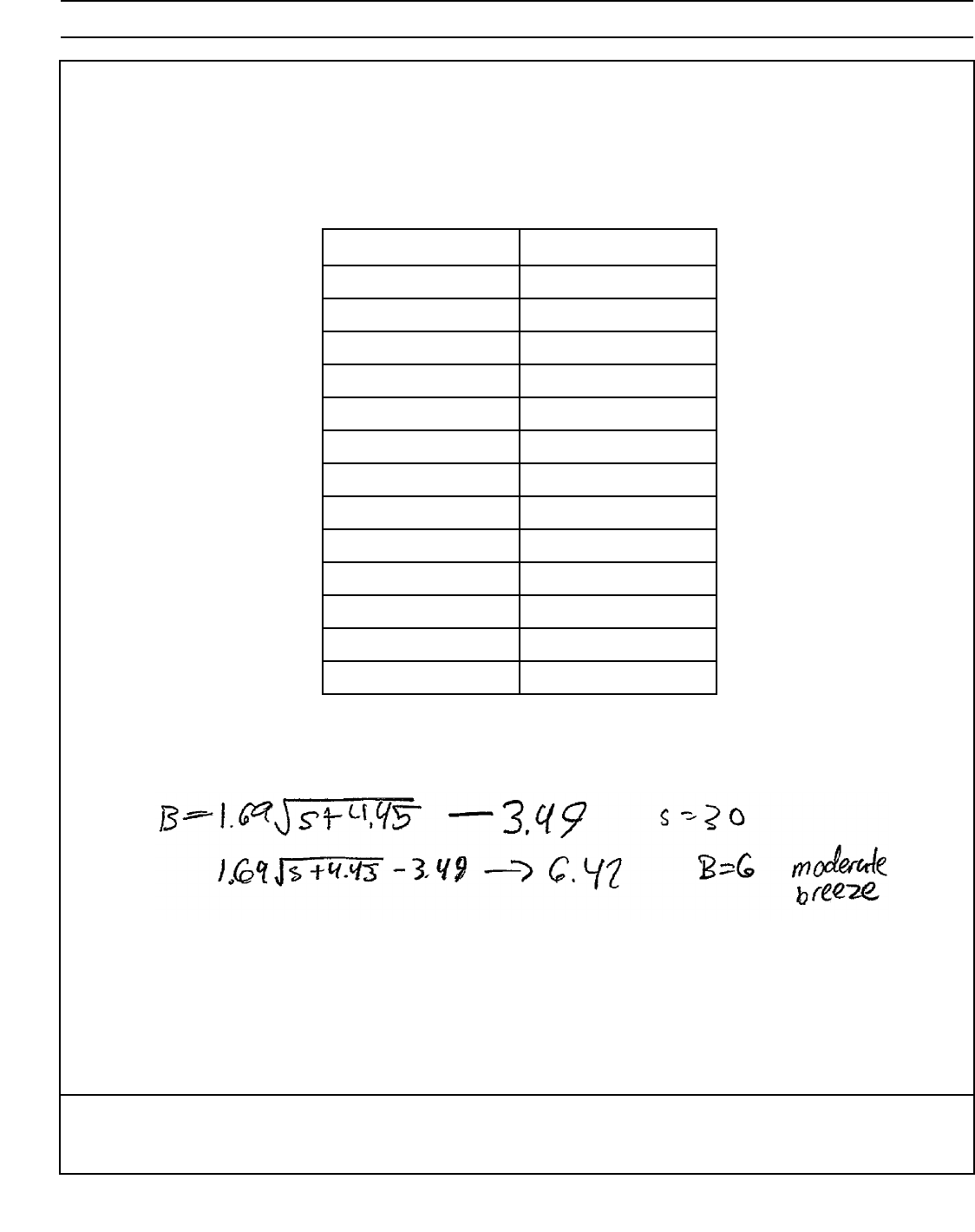
Algebra II – Aug. ’19 [73]
Question 37
Score 3: The student gave an incorrect classification and did not state the correct interval.
37 The Beaufort Wind Scale was devised by British Rear Admiral Sir Francis Beaufort, in 1805 based
upon observations of the effects of the wind. Beaufort numbers, B, are determined by the
equation B ⫽ 1.69 兹苵苵苵苵苵苵苵
s ⫹ 4.45 ⫺ 3.49, where s is the speed of the wind in mph, and B is rounded
to the nearest integer from 0 to 12.
Beaufort Wind Scale
Using the table above, classify the force of wind at a speed of 30 mph. Justify your answer.
Beaufort Number Force of Wind
0 Calm
1 Light air
2 Light breeze
3 Gentle breeze
4 Moderate breeze
5 Fresh breeze
6 Steady breeze
7 Moderate gale
8 Fresh gale
9 Strong gale
10 Whole gale
11 Storm
12 Hurricane
Question 37 is continued on the next page.
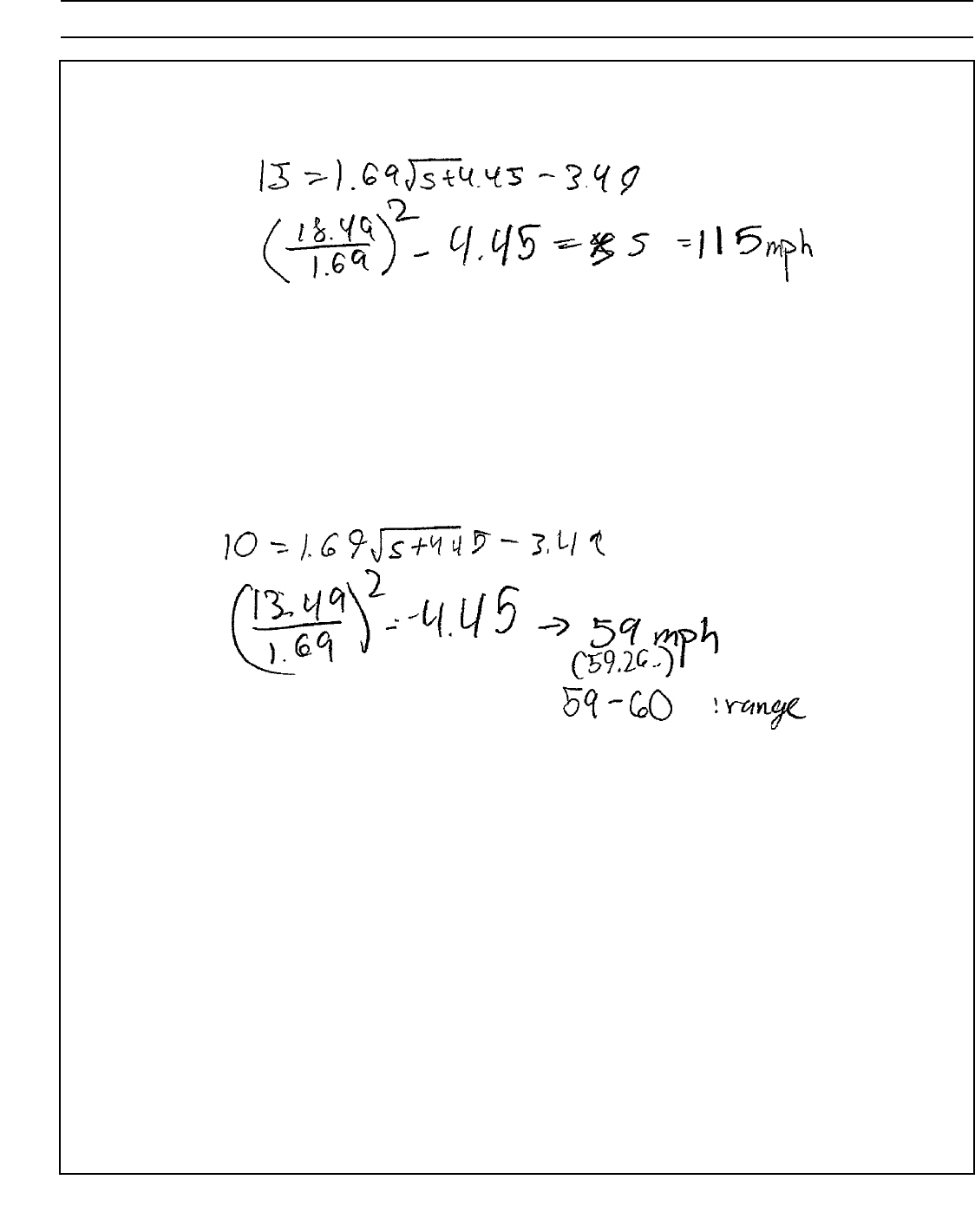
Algebra II – Aug. ’19 [74]
Question 37 continued.
In 1946, the scale was extended to accommodate strong hurricanes. A strong hurricane received
a B value of exactly 15. Algebraically determine the value of s, to the nearest mph.
Any B values that round to 10 receive a Beaufort number of 10. Using technology, find an
approximate range of wind speeds, to the nearest mph, associated with a Beaufort number of 10.

Algebra II – Aug. ’19 [75]
Question 37
Score 2: The student received credit for the second part.
37 The Beaufort Wind Scale was devised by British Rear Admiral Sir Francis Beaufort, in 1805 based
upon observations of the effects of the wind. Beaufort numbers, B, are determined by the
equation B ⫽ 1.69 兹苵苵苵苵苵苵苵
s ⫹ 4.45 ⫺ 3.49, where s is the speed of the wind in mph, and B is rounded
to the nearest integer from 0 to 12.
Beaufort Wind Scale
Using the table above, classify the force of wind at a speed of 30 mph. Justify your answer.
Beaufort Number Force of Wind
0 Calm
1 Light air
2 Light breeze
3 Gentle breeze
4 Moderate breeze
5 Fresh breeze
6 Steady breeze
7 Moderate gale
8 Fresh gale
9 Strong gale
10 Whole gale
11 Storm
12 Hurricane
Question 37 is continued on the next page.
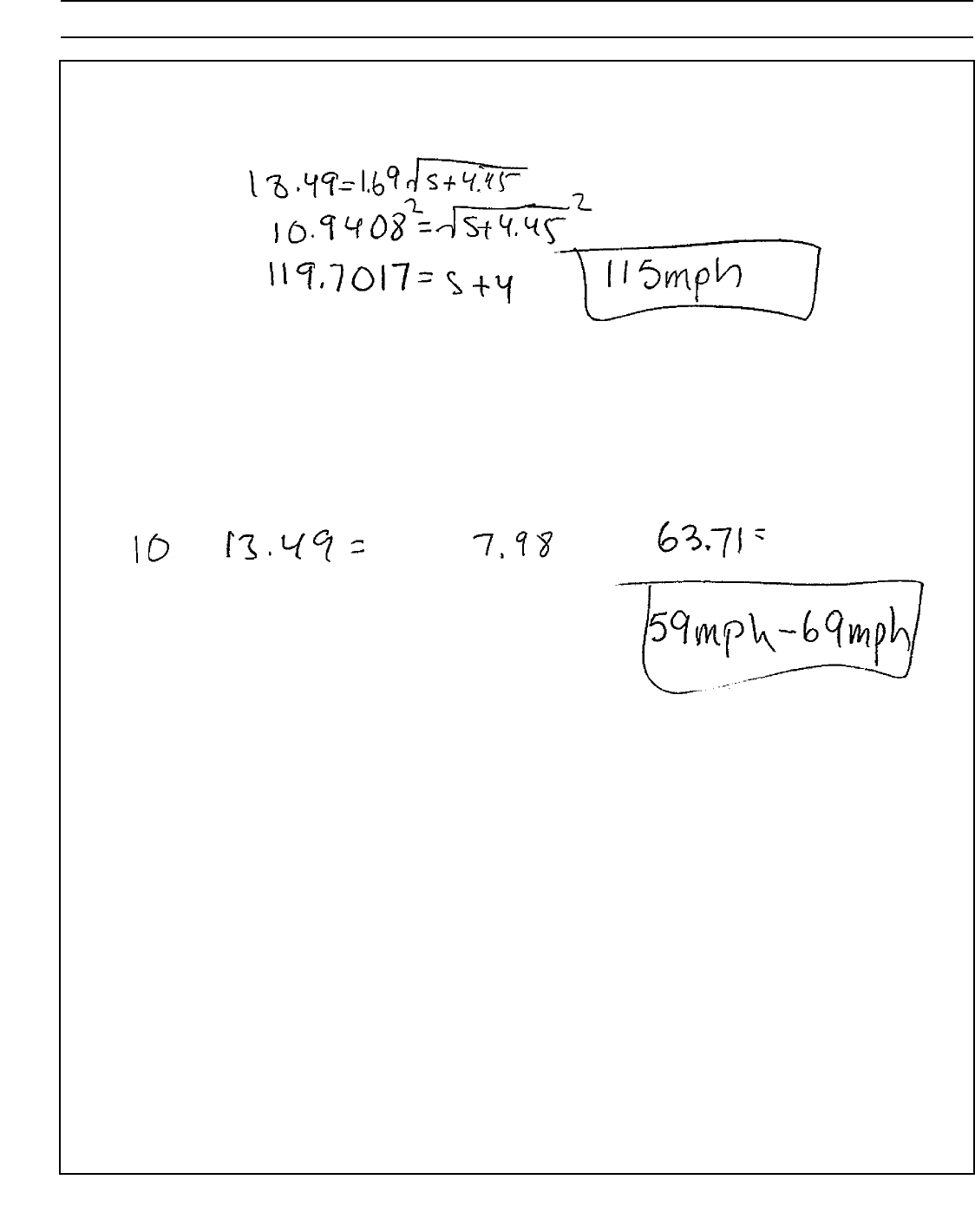
Algebra II – Aug. ’19 [76]
Question 37 continued.
In 1946, the scale was extended to accommodate strong hurricanes. A strong hurricane received
a B value of exactly 15. Algebraically determine the value of s, to the nearest mph.
Any B values that round to 10 receive a Beaufort number of 10. Using technology, find an
approximate range of wind speeds, to the nearest mph, associated with a Beaufort number of 10.

Algebra II – Aug. ’19 [77]
Question 37
Score 2: The student received credit for “steady breeze” and 115 with no work shown.
37 The Beaufort Wind Scale was devised by British Rear Admiral Sir Francis Beaufort, in 1805 based
upon observations of the effects of the wind. Beaufort numbers, B, are determined by the
equation B ⫽ 1.69 兹苵苵苵苵苵苵苵
s ⫹ 4.45 ⫺ 3.49, where s is the speed of the wind in mph, and B is rounded
to the nearest integer from 0 to 12.
Beaufort Wind Scale
Using the table above, classify the force of wind at a speed of 30 mph. Justify your answer.
Beaufort Number Force of Wind
0 Calm
1 Light air
2 Light breeze
3 Gentle breeze
4 Moderate breeze
5 Fresh breeze
6 Steady breeze
7 Moderate gale
8 Fresh gale
9 Strong gale
10 Whole gale
11 Storm
12 Hurricane
Question 37 is continued on the next page.
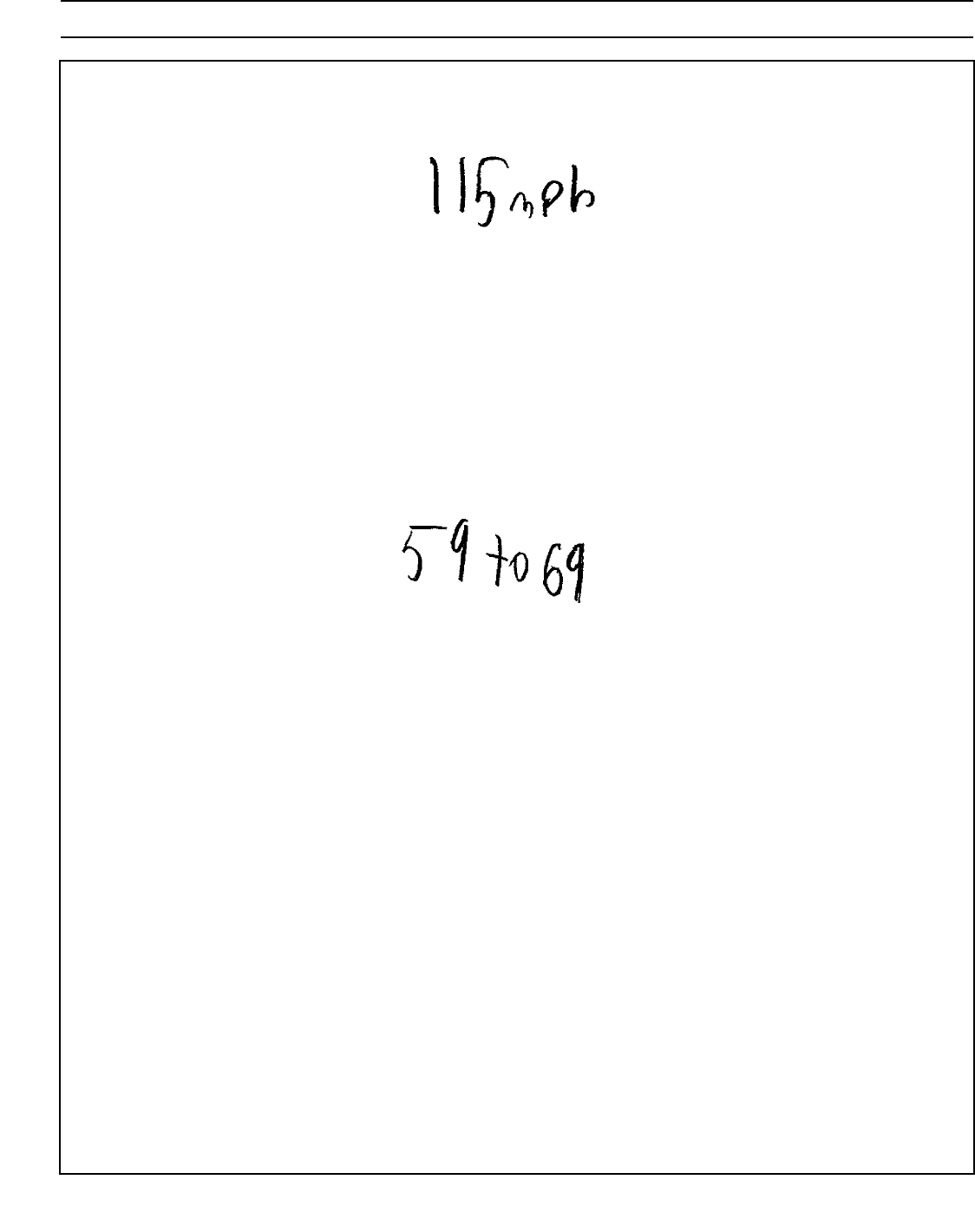
Algebra II – Aug. ’19 [78]
Question 37 continued.
In 1946, the scale was extended to accommodate strong hurricanes. A strong hurricane received
a B value of exactly 15. Algebraically determine the value of s, to the nearest mph.
Any B values that round to 10 receive a Beaufort number of 10. Using technology, find an
approximate range of wind speeds, to the nearest mph, associated with a Beaufort number of 10.
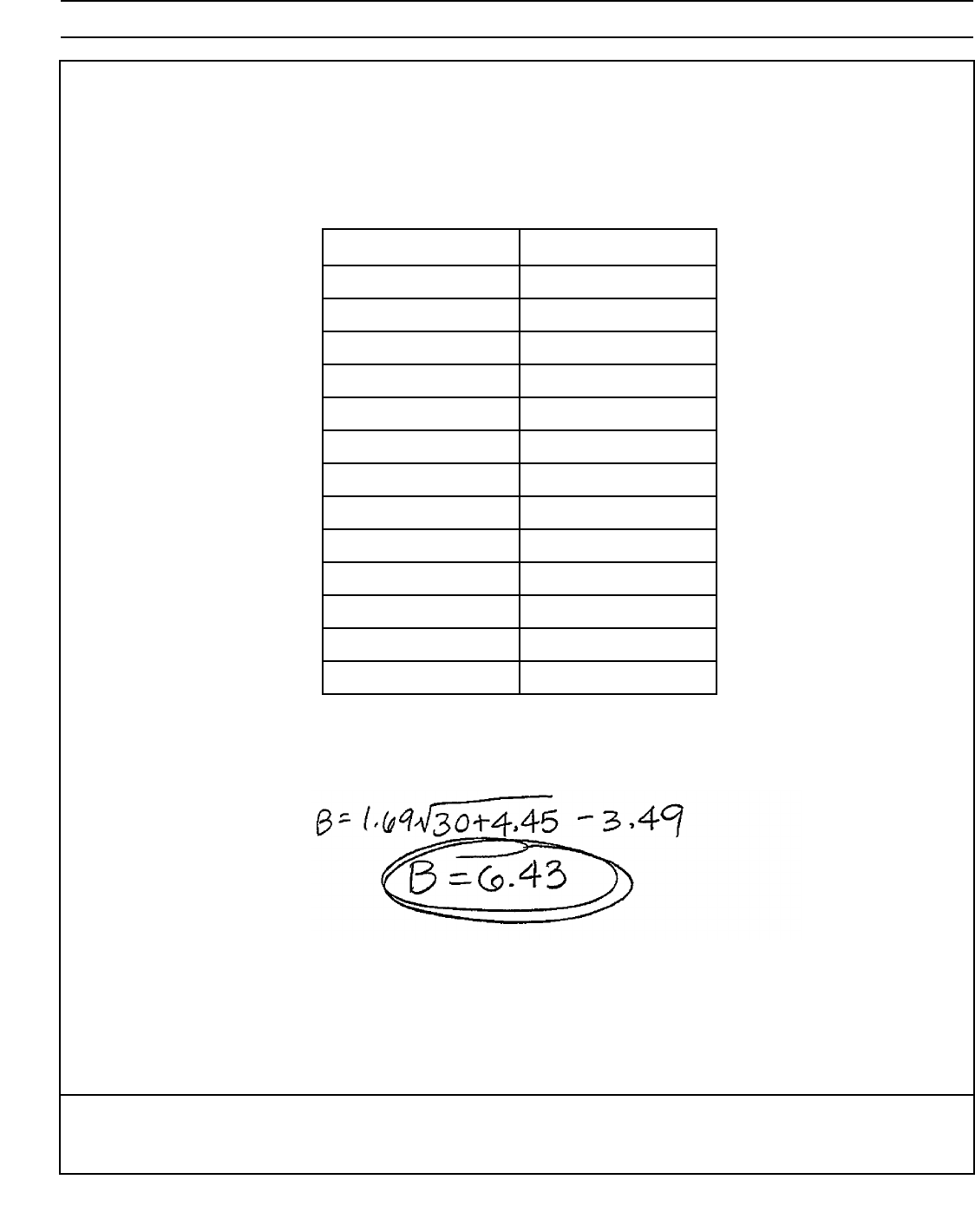
Algebra II – Aug. ’19 [79]
Question 37
Score 1: The student calculated an approximation of the Beaufort number correctly.
37 The Beaufort Wind Scale was devised by British Rear Admiral Sir Francis Beaufort, in 1805 based
upon observations of the effects of the wind. Beaufort numbers, B, are determined by the
equation B ⫽ 1.69 兹苵苵苵苵苵苵苵
s ⫹ 4.45 ⫺ 3.49, where s is the speed of the wind in mph, and B is rounded
to the nearest integer from 0 to 12.
Beaufort Wind Scale
Using the table above, classify the force of wind at a speed of 30 mph. Justify your answer.
Beaufort Number Force of Wind
0 Calm
1 Light air
2 Light breeze
3 Gentle breeze
4 Moderate breeze
5 Fresh breeze
6 Steady breeze
7 Moderate gale
8 Fresh gale
9 Strong gale
10 Whole gale
11 Storm
12 Hurricane
Question 37 is continued on the next page.

Algebra II – Aug. ’19 [80]
Question 37 continued.
In 1946, the scale was extended to accommodate strong hurricanes. A strong hurricane received
a B value of exactly 15. Algebraically determine the value of s, to the nearest mph.
Any B values that round to 10 receive a Beaufort number of 10. Using technology, find an
approximate range of wind speeds, to the nearest mph, associated with a Beaufort number of 10.

Algebra II – Aug. ’19 [81]
Question 37
Score 1: The student selected the correct category for a miscalculation of the Beaufort number.
37 The Beaufort Wind Scale was devised by British Rear Admiral Sir Francis Beaufort, in 1805 based
upon observations of the effects of the wind. Beaufort numbers, B, are determined by the
equation B ⫽ 1.69 兹苵苵苵苵苵苵苵
s ⫹ 4.45 ⫺ 3.49, where s is the speed of the wind in mph, and B is rounded
to the nearest integer from 0 to 12.
Beaufort Wind Scale
Using the table above, classify the force of wind at a speed of 30 mph. Justify your answer.
Beaufort Number Force of Wind
0 Calm
1 Light air
2 Light breeze
3 Gentle breeze
4 Moderate breeze
5 Fresh breeze
6 Steady breeze
7 Moderate gale
8 Fresh gale
9 Strong gale
10 Whole gale
11 Storm
12 Hurricane
Question 37 is continued on the next page.

Algebra II – Aug. ’19 [82]
Question 37 continued.
In 1946, the scale was extended to accommodate strong hurricanes. A strong hurricane received
a B value of exactly 15. Algebraically determine the value of s, to the nearest mph.
Any B values that round to 10 receive a Beaufort number of 10. Using technology, find an
approximate range of wind speeds, to the nearest mph, associated with a Beaufort number of 10.

Algebra II – Aug. ’19 [83]
Question 37
Score 0: The student did not show enough correct work to receive any credit.
37 The Beaufort Wind Scale was devised by British Rear Admiral Sir Francis Beaufort, in 1805 based
upon observations of the effects of the wind. Beaufort numbers, B, are determined by the
equation B ⫽ 1.69 兹苵苵苵苵苵苵苵
s ⫹ 4.45 ⫺ 3.49, where s is the speed of the wind in mph, and B is rounded
to the nearest integer from 0 to 12.
Beaufort Wind Scale
Using the table above, classify the force of wind at a speed of 30 mph. Justify your answer.
Beaufort Number Force of Wind
0 Calm
1 Light air
2 Light breeze
3 Gentle breeze
4 Moderate breeze
5 Fresh breeze
6 Steady breeze
7 Moderate gale
8 Fresh gale
9 Strong gale
10 Whole gale
11 Storm
12 Hurricane
Question 37 is continued on the next page.
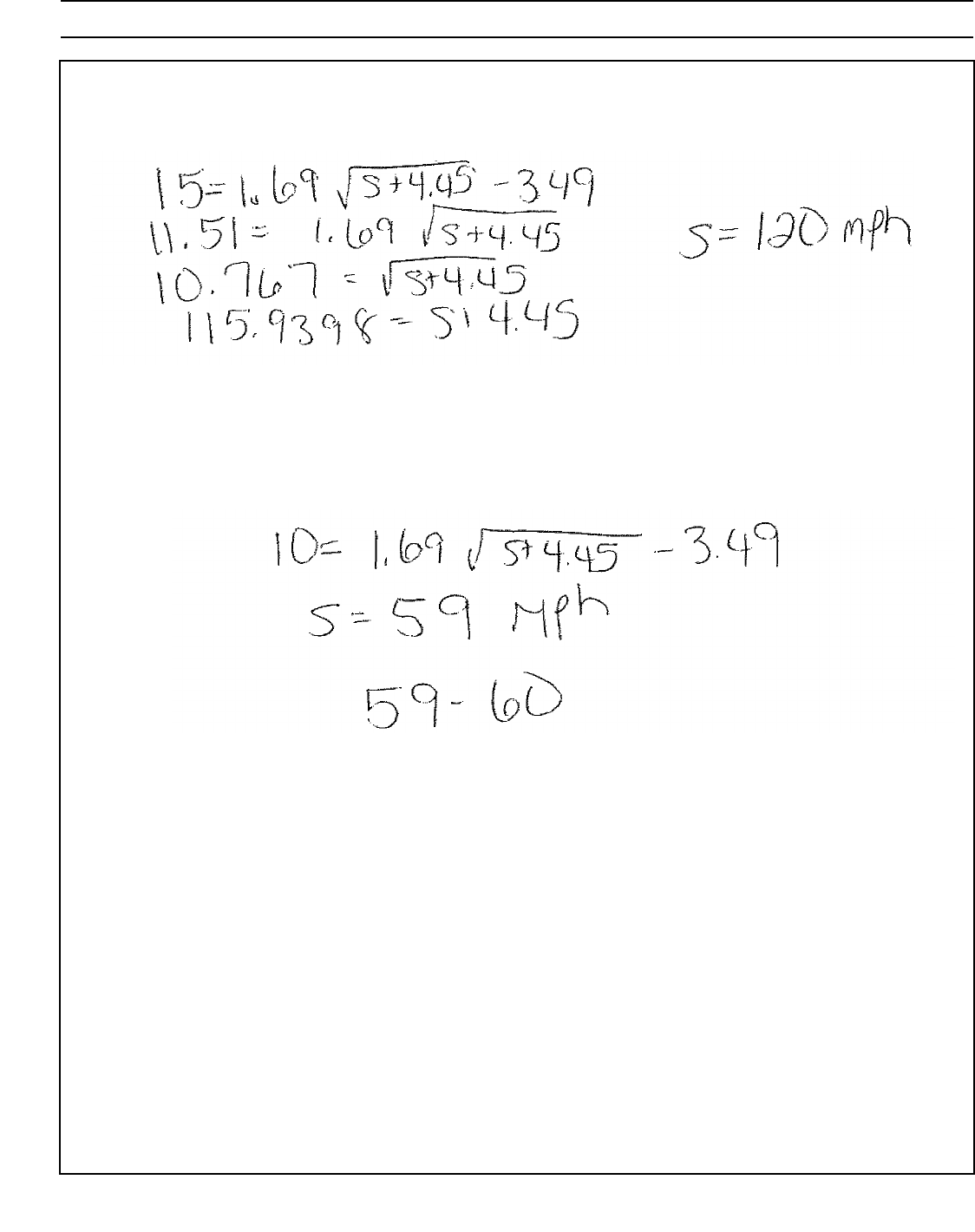
Algebra II – Aug. ’19 [84]
Question 37 continued.
In 1946, the scale was extended to accommodate strong hurricanes. A strong hurricane received
a B value of exactly 15. Algebraically determine the value of s, to the nearest mph.
Any B values that round to 10 receive a Beaufort number of 10. Using technology, find an
approximate range of wind speeds, to the nearest mph, associated with a Beaufort number of 10.
